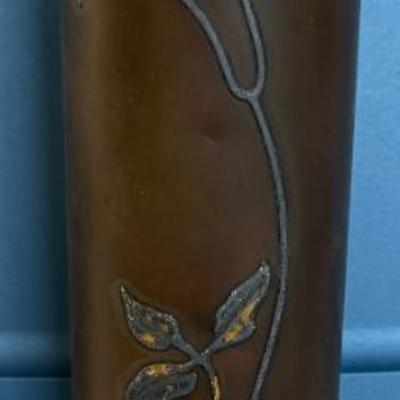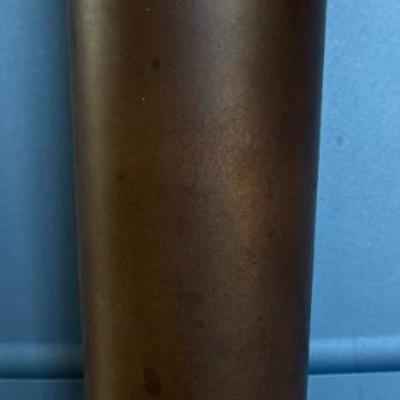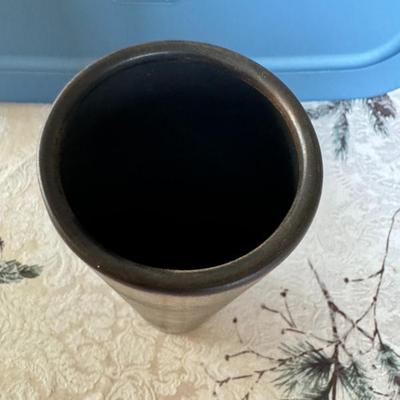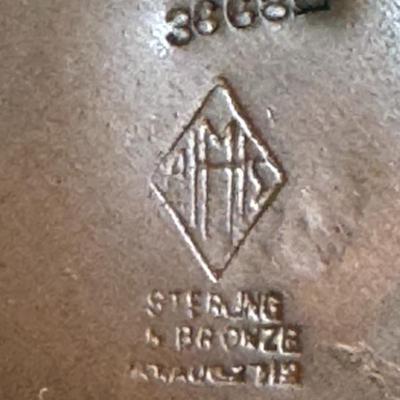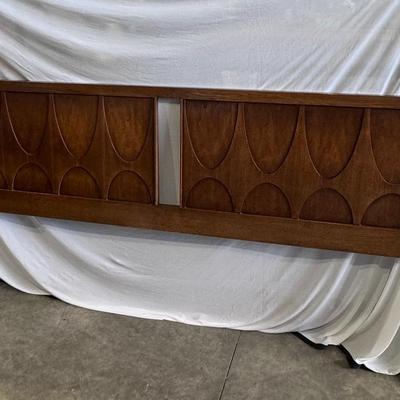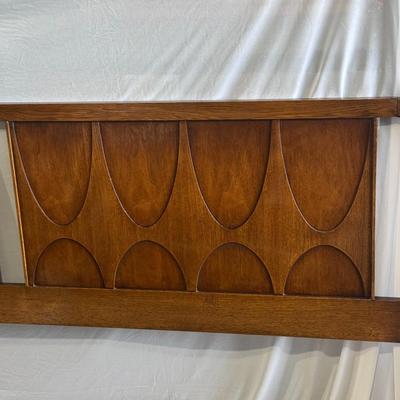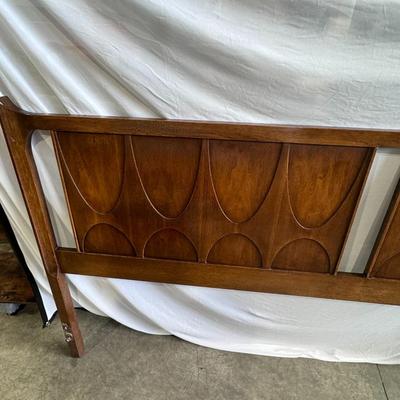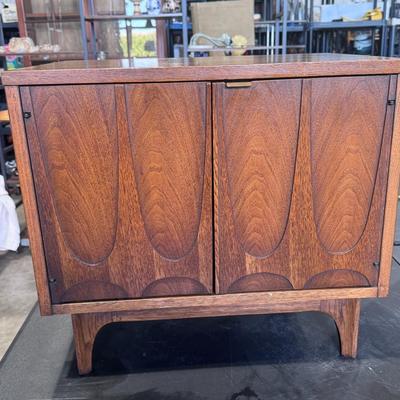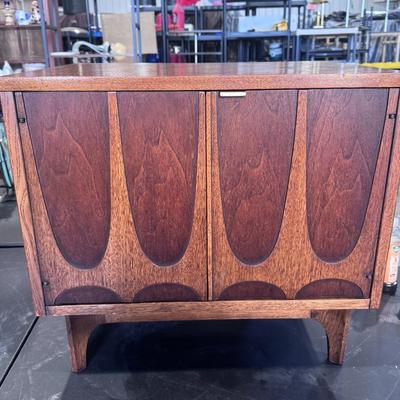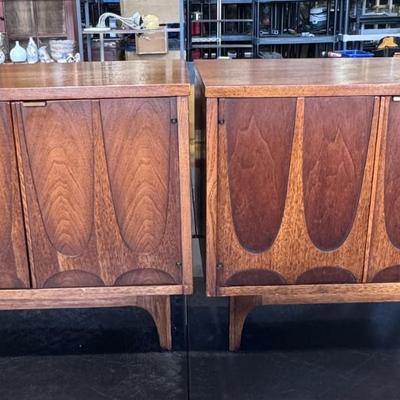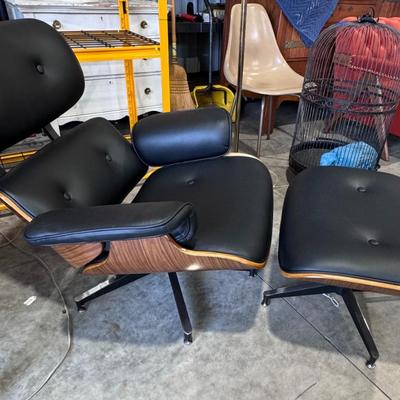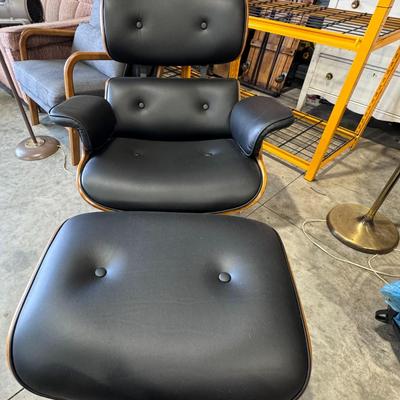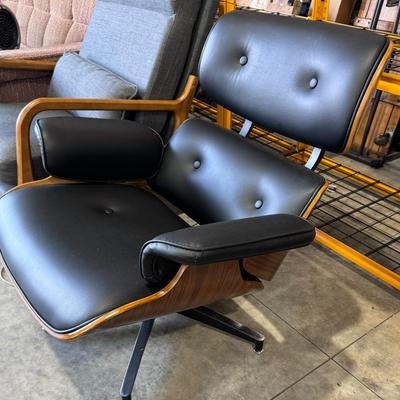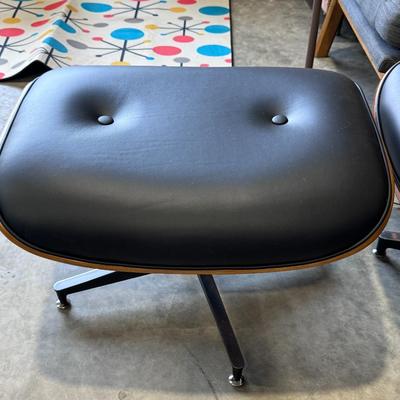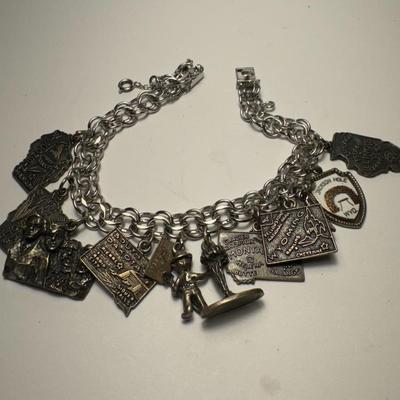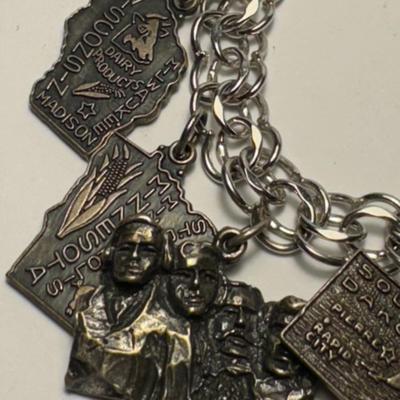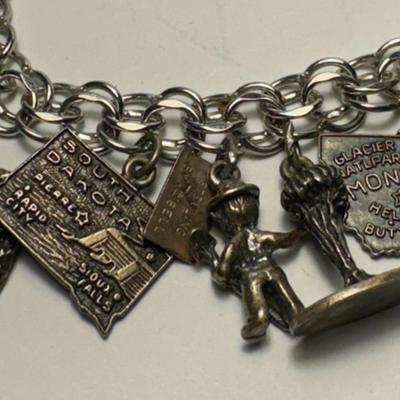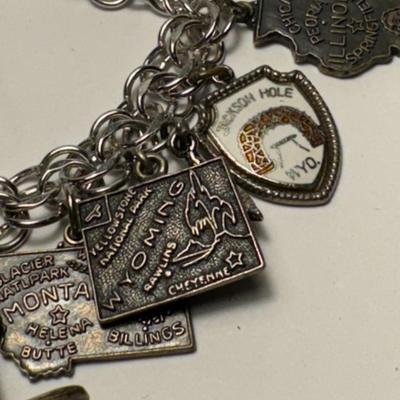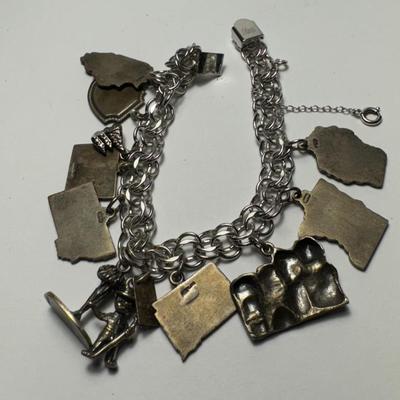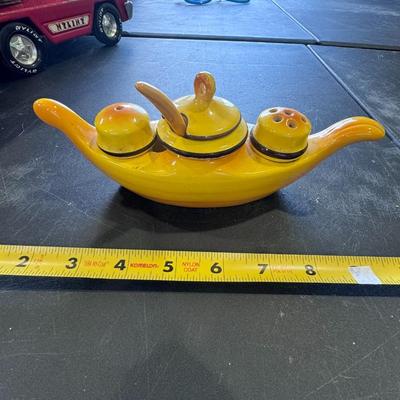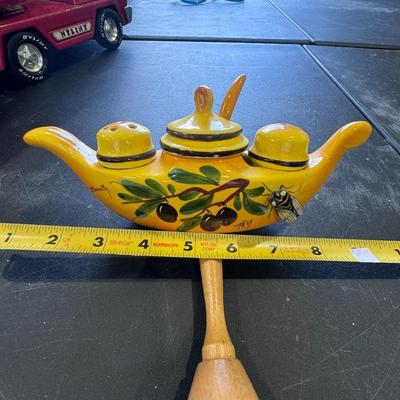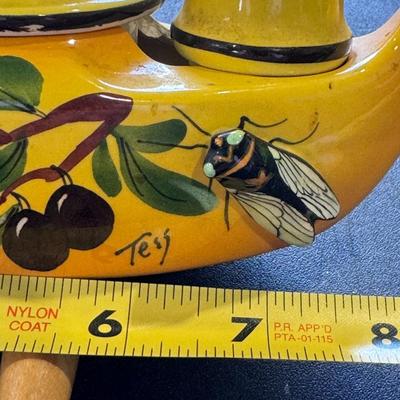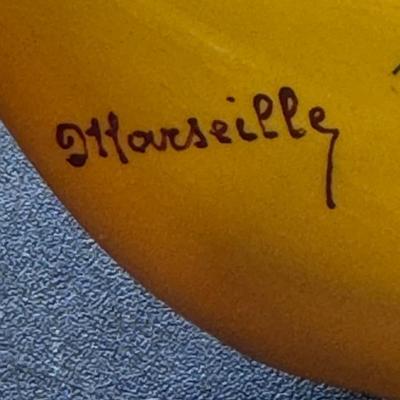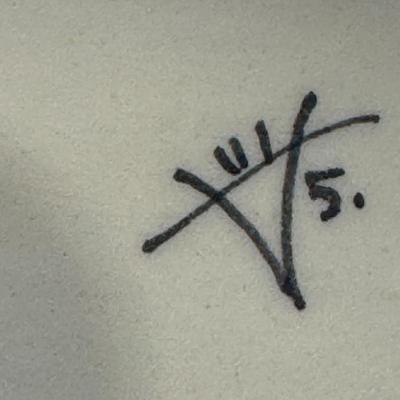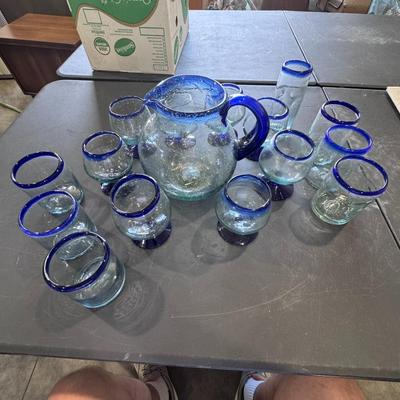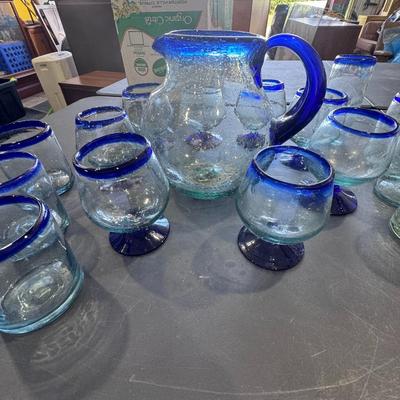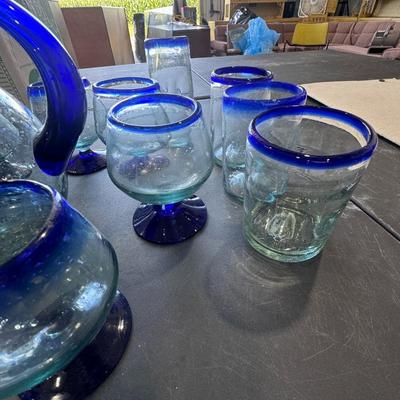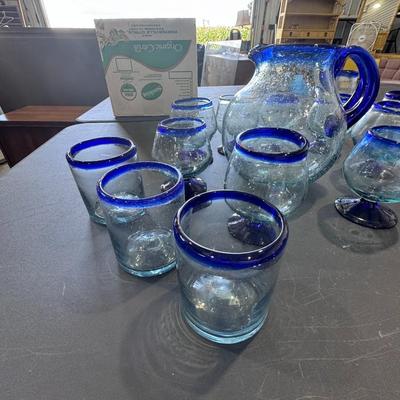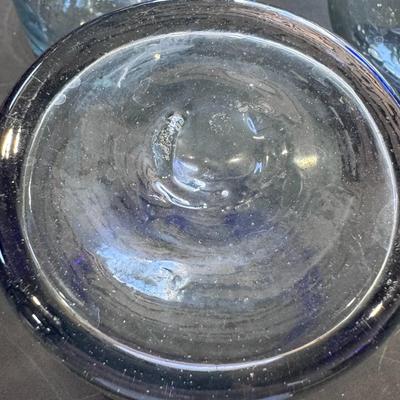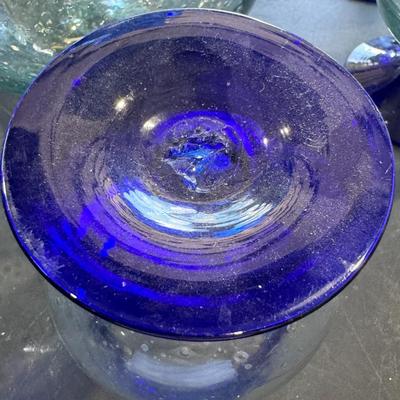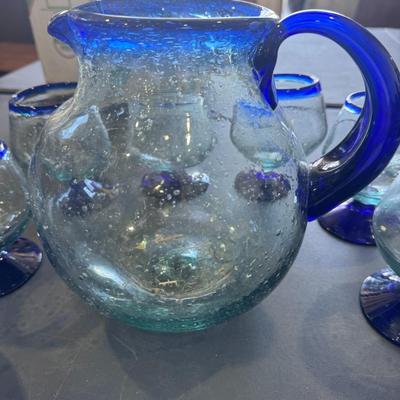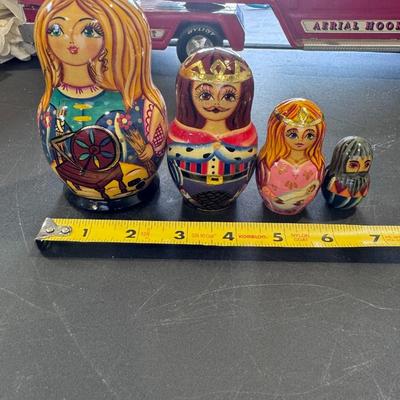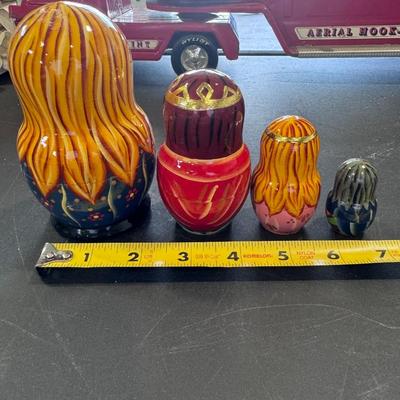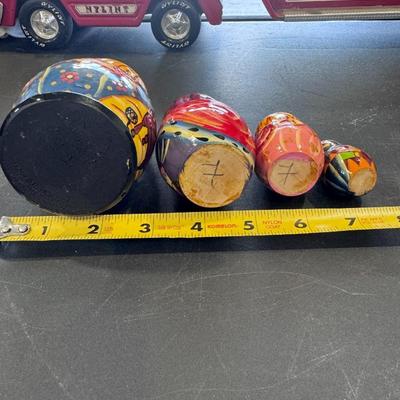-
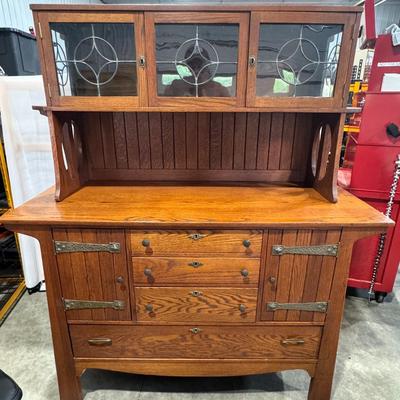
Commissioned early 1900's. Commissioned by the owner of Poor Reds in El Dorado California ( home of the Gold Cadillac) This buffet was the original piece that held the drink ware for the Golden Cadillac Base dimensions 60" wide x 25" deep x 69" tall Top section 45" wide x 15" deep x 30" tall 5 / 1369 -
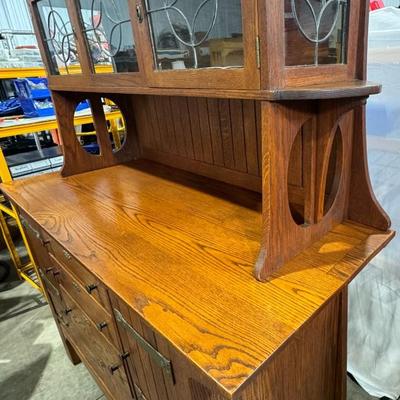
Commissioned early 1900's. Commissioned by the owner of Poor Reds in El Dorado California ( home of the Gold Cadillac) This buffet was the original piece that held the drink ware for the Golden Cadillac Base dimensions 60" wide x 25" deep x 69" tall Top section 45" wide x 15" deep x 30" tall 6 / 1369 -
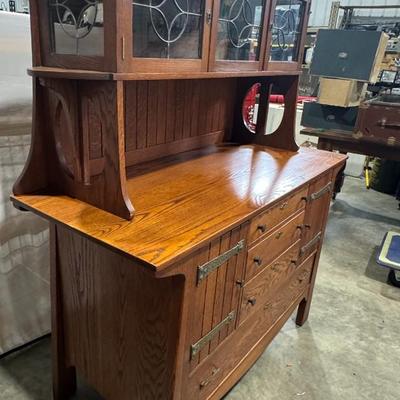
Commissioned early 1900's. Commissioned by the owner of Poor Reds in El Dorado California ( home of the Gold Cadillac) This buffet was the original piece that held the drink ware for the Golden Cadillac Base dimensions 60" wide x 25" deep x 69" tall Top section 45" wide x 15" deep x 30" tall 7 / 1369 -
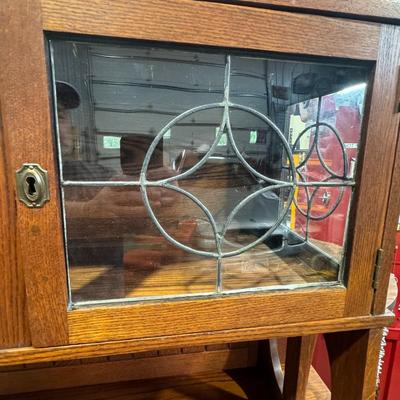
Commissioned early 1900's. Commissioned by the owner of Poor Reds in El Dorado California ( home of the Gold Cadillac) This buffet was the original piece that held the drink ware for the Golden Cadillac Base dimensions 60" wide x 25" deep x 69" tall Top section 45" wide x 15" deep x 30" tall 8 / 1369 -
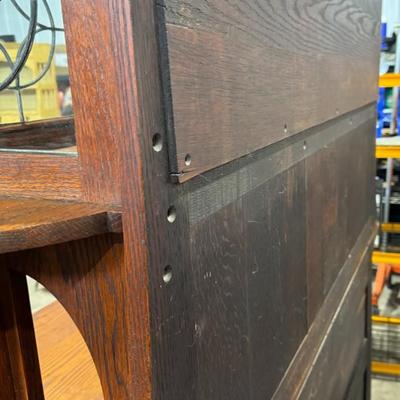
Commissioned early 1900's. Commissioned by the owner of Poor Reds in El Dorado California ( home of the Gold Cadillac) This buffet was the original piece that held the drink ware for the Golden Cadillac Base dimensions 60" wide x 25" deep x 69" tall Top section 45" wide x 15" deep x 30" tall 9 / 1369 -
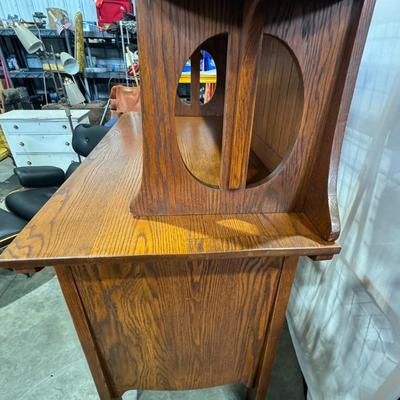
Commissioned early 1900's. Commissioned by the owner of Poor Reds in El Dorado California ( home of the Gold Cadillac) This buffet was the original piece that held the drink ware for the Golden Cadillac Base dimensions 60" wide x 25" deep x 69" tall Top section 45" wide x 15" deep x 30" tall 10 / 1369 -
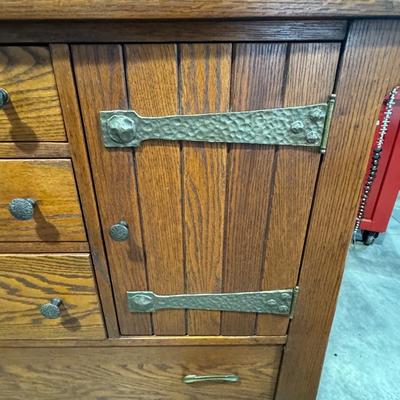
Commissioned early 1900's. Commissioned by the owner of Poor Reds in El Dorado California ( home of the Gold Cadillac) This buffet was the original piece that held the drink ware for the Golden Cadillac Base dimensions 60" wide x 25" deep x 69" tall Top section 45" wide x 15" deep x 30" tall 11 / 1369 -
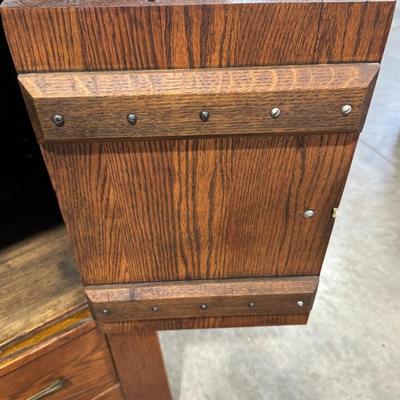
Commissioned early 1900's. Commissioned by the owner of Poor Reds in El Dorado California ( home of the Gold Cadillac) This buffet was the original piece that held the drink ware for the Golden Cadillac Base dimensions 60" wide x 25" deep x 69" tall Top section 45" wide x 15" deep x 30" tall 12 / 1369 -
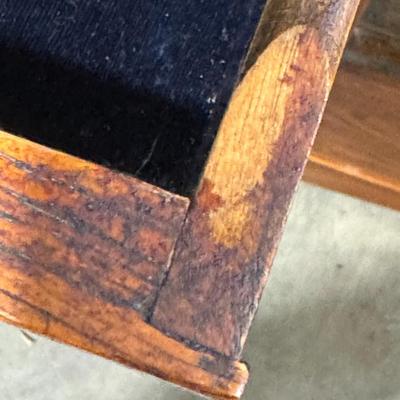
Commissioned early 1900's. Commissioned by the owner of Poor Reds in El Dorado California ( home of the Gold Cadillac) This buffet was the original piece that held the drink ware for the Golden Cadillac Base dimensions 60" wide x 25" deep x 69" tall Top section 45" wide x 15" deep x 30" tall 13 / 1369 -
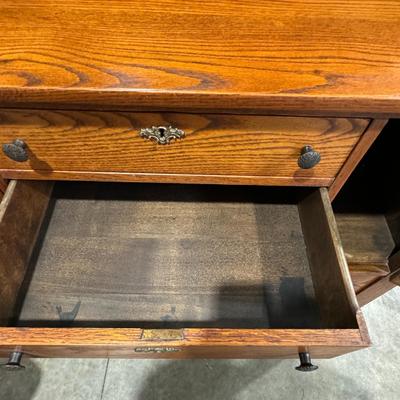
Commissioned early 1900's. Commissioned by the owner of Poor Reds in El Dorado California ( home of the Gold Cadillac) This buffet was the original piece that held the drink ware for the Golden Cadillac Base dimensions 60" wide x 25" deep x 69" tall Top section 45" wide x 15" deep x 30" tall 14 / 1369 -
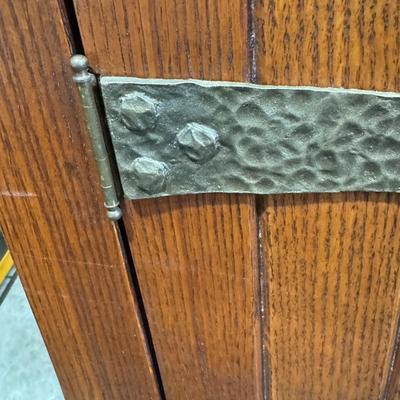
Commissioned early 1900's. Commissioned by the owner of Poor Reds in El Dorado California ( home of the Gold Cadillac) This buffet was the original piece that held the drink ware for the Golden Cadillac Base dimensions 60" wide x 25" deep x 69" tall Top section 45" wide x 15" deep x 30" tall 15 / 1369 -
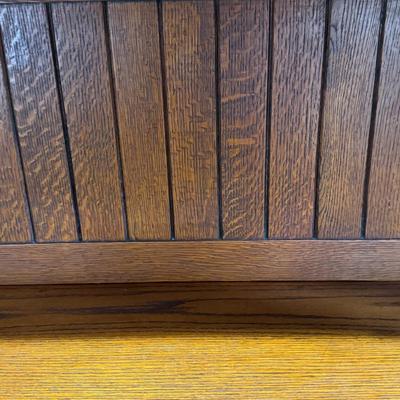
Commissioned early 1900's. Commissioned by the owner of Poor Reds in El Dorado California ( home of the Gold Cadillac) This buffet was the original piece that held the drink ware for the Golden Cadillac Base dimensions 60" wide x 25" deep x 69" tall Top section 45" wide x 15" deep x 30" tall 16 / 1369 -
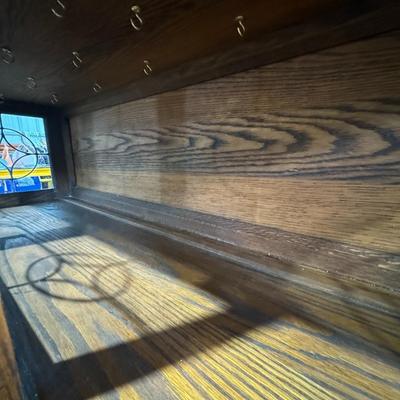
Commissioned early 1900's. Commissioned by the owner of Poor Reds in El Dorado California ( home of the Gold Cadillac) This buffet was the original piece that held the drink ware for the Golden Cadillac Base dimensions 60" wide x 25" deep x 69" tall Top section 45" wide x 15" deep x 30" tall 17 / 1369 -
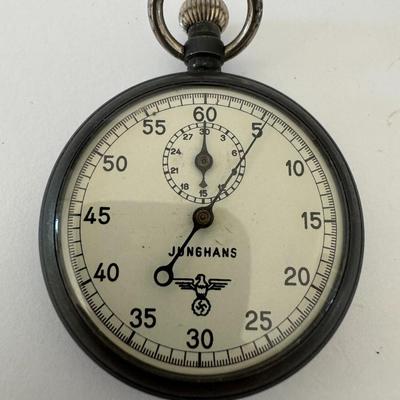
Junghans Kriegsmarine Torpedo Stopwatch, a German-made stopwatch used by the German Navy (Kriegsmarine) during World War II, notably for timing torpedo runs and depth charge detonations. Here's more information about it: Manufacturer and Era: It was manufactured by Junghans, a German watch company founded in 1861. This particular model was produced between 1939 and 1945 for military use. Features: It typically features a steel case, a 60-second outer dial, and a smaller 30-minute inset dial, as seen in the image. The top knob controls winding, starting, stopping, and resetting the stopwatch. Kriegsmarine Markings: Original Kriegsmarine-issued Junghans stopwatches usually have the "KM" (Kriegsmarine) marking and a German national eagle with a swastika engraved on the case back, though some later examples might have them on the dial. Functionality: These mechanical stopwatches were crucial for precise timing in naval operations, particularly for U-boat crews and E-boats in the North Atlantic. 18 / 1369 -
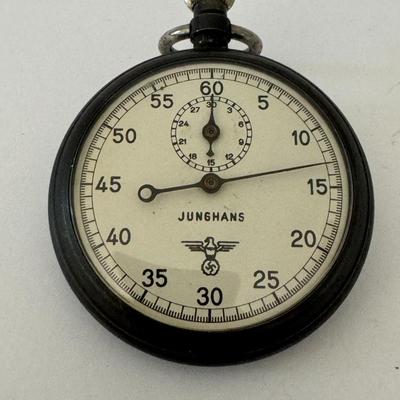
Junghans Kriegsmarine Torpedo Stopwatch, a German-made stopwatch used by the German Navy (Kriegsmarine) during World War II, notably for timing torpedo runs and depth charge detonations. Here's more information about it: Manufacturer and Era: It was manufactured by Junghans, a German watch company founded in 1861. This particular model was produced between 1939 and 1945 for military use. Features: It typically features a steel case, a 60-second outer dial, and a smaller 30-minute inset dial, as seen in the image. The top knob controls winding, starting, stopping, and resetting the stopwatch. Kriegsmarine Markings: Original Kriegsmarine-issued Junghans stopwatches usually have the "KM" (Kriegsmarine) marking and a German national eagle with a swastika engraved on the case back, though some later examples might have them on the dial. Functionality: These mechanical stopwatches were crucial for precise timing in naval operations, particularly for U-boat crews and E-boats in the North Atlantic. 19 / 1369 -
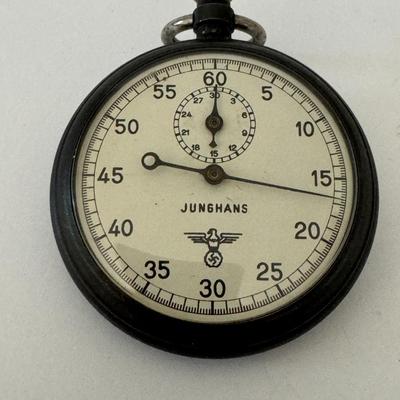
Junghans Kriegsmarine Torpedo Stopwatch, a German-made stopwatch used by the German Navy (Kriegsmarine) during World War II, notably for timing torpedo runs and depth charge detonations. Here's more information about it: Manufacturer and Era: It was manufactured by Junghans, a German watch company founded in 1861. This particular model was produced between 1939 and 1945 for military use. Features: It typically features a steel case, a 60-second outer dial, and a smaller 30-minute inset dial, as seen in the image. The top knob controls winding, starting, stopping, and resetting the stopwatch. Kriegsmarine Markings: Original Kriegsmarine-issued Junghans stopwatches usually have the "KM" (Kriegsmarine) marking and a German national eagle with a swastika engraved on the case back, though some later examples might have them on the dial. Functionality: These mechanical stopwatches were crucial for precise timing in naval operations, particularly for U-boat crews and E-boats in the North Atlantic. 20 / 1369 -
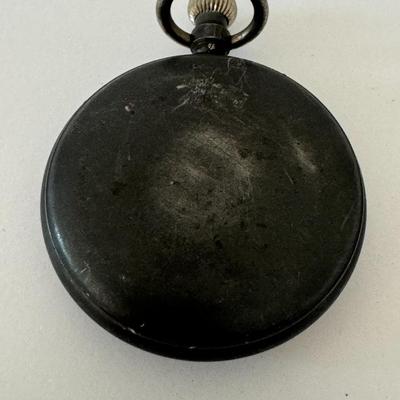
Junghans Kriegsmarine Torpedo Stopwatch, a German-made stopwatch used by the German Navy (Kriegsmarine) during World War II, notably for timing torpedo runs and depth charge detonations. Here's more information about it: Manufacturer and Era: It was manufactured by Junghans, a German watch company founded in 1861. This particular model was produced between 1939 and 1945 for military use. Features: It typically features a steel case, a 60-second outer dial, and a smaller 30-minute inset dial, as seen in the image. The top knob controls winding, starting, stopping, and resetting the stopwatch. Kriegsmarine Markings: Original Kriegsmarine-issued Junghans stopwatches usually have the "KM" (Kriegsmarine) marking and a German national eagle with a swastika engraved on the case back, though some later examples might have them on the dial. Functionality: These mechanical stopwatches were crucial for precise timing in naval operations, particularly for U-boat crews and E-boats in the North Atlantic. 21 / 1369 -
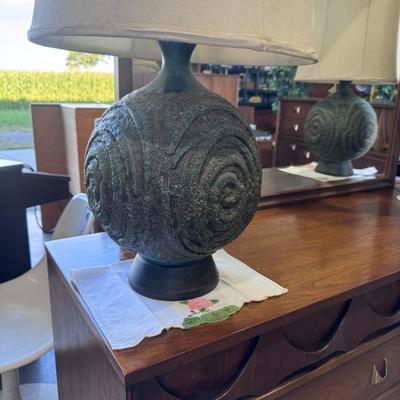
Creator: Marcello Fantoni (Designer) Dimensions: Height: 21 in (53.34 cm)Diameter: 11 in (27.94 cm) Style: Mid-Century Modern (Of the Period) Materials and Techniques: Brass,Ceramic,Fired Place of Origin: Italy Mid-Century Modern Italian ceramic table lamp, specifically attributed to the renowned artist Marcello Fantoni. Here's more information about this style of lamp: Designer & Origin: Marcello Fantoni (1915–2011) was a prominent Italian ceramist who opened his studio in Florence in 1936. He became known for his expressive and sculptural ceramic works, including lamps, particularly during the 1950s and 60s. Style & Period: This lamp is a classic example of Mid-Century Modern design, characterized by its organic shape and textured, often "lava-like," glazes, sometimes incorporating elements of Brutalism. The specific piece in your image, with its distinctive spiral pattern and textured finish, dates back to circa the 1950s. Materials & Features: Fantoni lamps commonly feature a ceramic body, often with a unique glaze and sculptural details, mounted on a base (sometimes wood or metal). The one in your image appears to be a ceramic lamp with a textured, possibly green or dark-toned glaze and a spiral motif. 22 / 1369 -
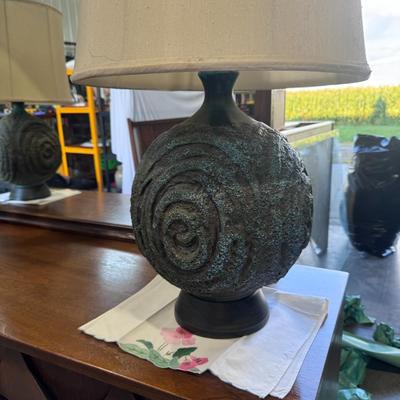
Creator: Marcello Fantoni (Designer) Dimensions: Height: 21 in (53.34 cm)Diameter: 11 in (27.94 cm) Style: Mid-Century Modern (Of the Period) Materials and Techniques: Brass,Ceramic,Fired Place of Origin: Italy Mid-Century Modern Italian ceramic table lamp, specifically attributed to the renowned artist Marcello Fantoni. Here's more information about this style of lamp: Designer & Origin: Marcello Fantoni (1915–2011) was a prominent Italian ceramist who opened his studio in Florence in 1936. He became known for his expressive and sculptural ceramic works, including lamps, particularly during the 1950s and 60s. Style & Period: This lamp is a classic example of Mid-Century Modern design, characterized by its organic shape and textured, often "lava-like," glazes, sometimes incorporating elements of Brutalism. The specific piece in your image, with its distinctive spiral pattern and textured finish, dates back to circa the 1950s. Materials & Features: Fantoni lamps commonly feature a ceramic body, often with a unique glaze and sculptural details, mounted on a base (sometimes wood or metal). The one in your image appears to be a ceramic lamp with a textured, possibly green or dark-toned glaze and a spiral motif. 23 / 1369 -
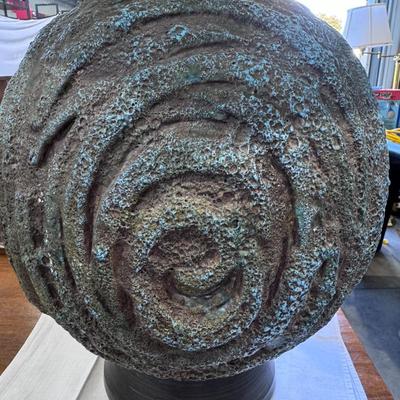
Creator: Marcello Fantoni (Designer) Dimensions: Height: 21 in (53.34 cm)Diameter: 11 in (27.94 cm) Style: Mid-Century Modern (Of the Period) Materials and Techniques: Brass,Ceramic,Fired Place of Origin: Italy Mid-Century Modern Italian ceramic table lamp, specifically attributed to the renowned artist Marcello Fantoni. Here's more information about this style of lamp: Designer & Origin: Marcello Fantoni (1915–2011) was a prominent Italian ceramist who opened his studio in Florence in 1936. He became known for his expressive and sculptural ceramic works, including lamps, particularly during the 1950s and 60s. Style & Period: This lamp is a classic example of Mid-Century Modern design, characterized by its organic shape and textured, often "lava-like," glazes, sometimes incorporating elements of Brutalism. The specific piece in your image, with its distinctive spiral pattern and textured finish, dates back to circa the 1950s. Materials & Features: Fantoni lamps commonly feature a ceramic body, often with a unique glaze and sculptural details, mounted on a base (sometimes wood or metal). The one in your image appears to be a ceramic lamp with a textured, possibly green or dark-toned glaze and a spiral motif. 24 / 1369 -
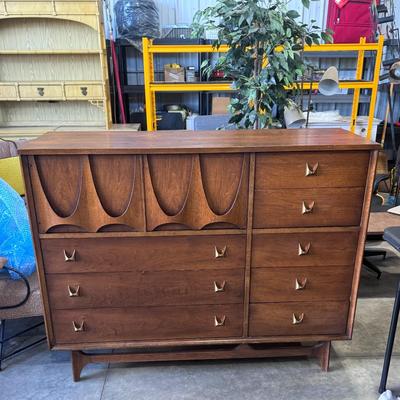
An outstanding Mid-Century walnut highboy dresser or chest of drawers from the Broyhill Brasilia line, circa 1960s. The chest features eight dovetailed drawers with signature brass handles. Includes open storage with two dividers behind sculpted arched doors. Creator: Broyhill Brasilia (Manufacturer) Dimensions: Height: 43.25 in (109.86 cm)Width: 54 in (137.16 cm)Depth: 19 in (48.26 cm) Style: Mid-Century Modern (Of the Period) Materials and Techniques: Walnut Place of Origin: United States Period: 1960-1969 25 / 1369 -
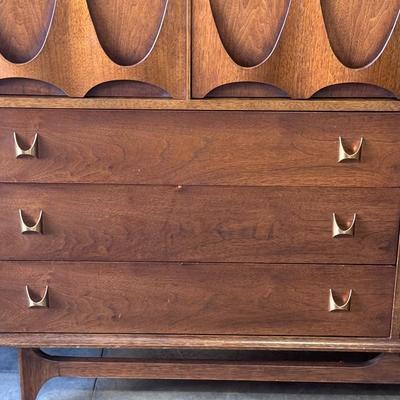
An outstanding Mid-Century walnut highboy dresser or chest of drawers from the Broyhill Brasilia line, circa 1960s. The chest features eight dovetailed drawers with signature brass handles. Includes open storage with two dividers behind sculpted arched doors. Creator: Broyhill Brasilia (Manufacturer) Dimensions: Height: 43.25 in (109.86 cm)Width: 54 in (137.16 cm)Depth: 19 in (48.26 cm) Style: Mid-Century Modern (Of the Period) Materials and Techniques: Walnut Place of Origin: United States Period: 1960-1969 26 / 1369 -
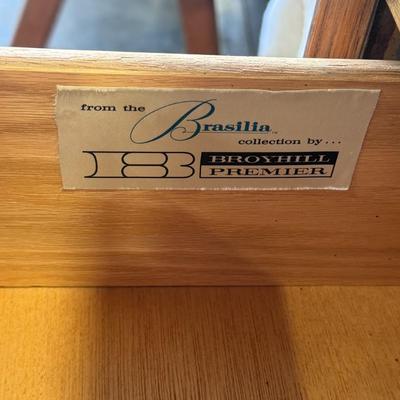
An outstanding Mid-Century walnut highboy dresser or chest of drawers from the Broyhill Brasilia line, circa 1960s. The chest features eight dovetailed drawers with signature brass handles. Includes open storage with two dividers behind sculpted arched doors. Creator: Broyhill Brasilia (Manufacturer) Dimensions: Height: 43.25 in (109.86 cm)Width: 54 in (137.16 cm)Depth: 19 in (48.26 cm) Style: Mid-Century Modern (Of the Period) Materials and Techniques: Walnut Place of Origin: United States Period: 1960-1969 27 / 1369 -
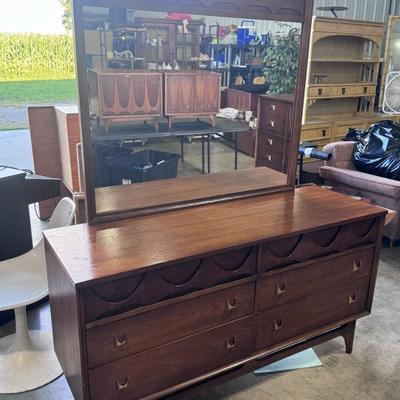
Here's some information about this iconic piece: Design Inspiration: The Brasilia collection by Broyhill, popular in the 1960s, was inspired by the distinctive architectural style of Brazil's capital city, Brasília, particularly the work of architect Oscar Niemeyer. This influence is evident in the sculpted, undulating wood details found on pieces like this dresser. Materials: These pieces are typically constructed from solid wood (often poplar) clad in black walnut veneer, known for its rich color and grain, sometimes accented with brass hardware. Features: The dresser features a six-drawer configuration and often comes with a matching mirror, characterized by a unique, sculptural frame. The drawers are typically well-constructed with features like dovetail joinery. Significance: Broyhill Brasilia furniture is highly sought after by collectors and enthusiasts of Mid-Century Modern design due to its distinctive aesthetic and quality craftsmanship. It represents a period of innovation in American furniture design, emphasizing clean lines and functionality. 28 / 1369 -
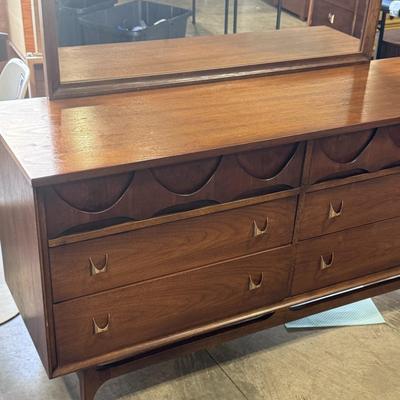
Here's some information about this iconic piece: Design Inspiration: The Brasilia collection by Broyhill, popular in the 1960s, was inspired by the distinctive architectural style of Brazil's capital city, Brasília, particularly the work of architect Oscar Niemeyer. This influence is evident in the sculpted, undulating wood details found on pieces like this dresser. Materials: These pieces are typically constructed from solid wood (often poplar) clad in black walnut veneer, known for its rich color and grain, sometimes accented with brass hardware. Features: The dresser features a six-drawer configuration and often comes with a matching mirror, characterized by a unique, sculptural frame. The drawers are typically well-constructed with features like dovetail joinery. Significance: Broyhill Brasilia furniture is highly sought after by collectors and enthusiasts of Mid-Century Modern design due to its distinctive aesthetic and quality craftsmanship. It represents a period of innovation in American furniture design, emphasizing clean lines and functionality. 29 / 1369 -
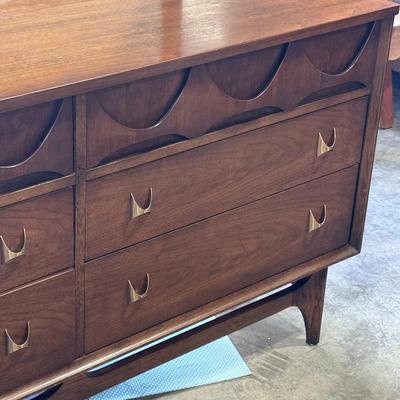
Here's some information about this iconic piece: Design Inspiration: The Brasilia collection by Broyhill, popular in the 1960s, was inspired by the distinctive architectural style of Brazil's capital city, Brasília, particularly the work of architect Oscar Niemeyer. This influence is evident in the sculpted, undulating wood details found on pieces like this dresser. Materials: These pieces are typically constructed from solid wood (often poplar) clad in black walnut veneer, known for its rich color and grain, sometimes accented with brass hardware. Features: The dresser features a six-drawer configuration and often comes with a matching mirror, characterized by a unique, sculptural frame. The drawers are typically well-constructed with features like dovetail joinery. Significance: Broyhill Brasilia furniture is highly sought after by collectors and enthusiasts of Mid-Century Modern design due to its distinctive aesthetic and quality craftsmanship. It represents a period of innovation in American furniture design, emphasizing clean lines and functionality. 30 / 1369 -
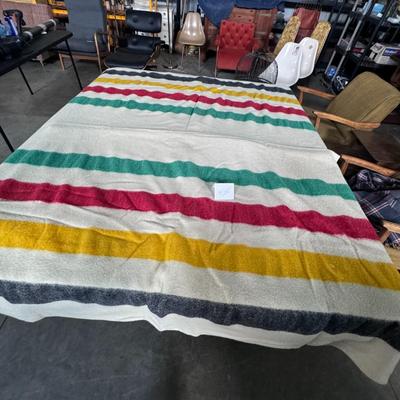
Point blankets and North America Point blankets are perhaps the Witney industry's most famous product. They were traded mainly with North America, where they came to have a cultural significance far beyond that of mere bed coverings. The origins of points Three and a half point blanket showing detail of the points. Three and a half point blanket showing detail of the points.Point blankets were so called because they had several short lines known as 'points' sewn or woven into one edge near a corner; the number of points on a blanket was intended to indicate its size and therefore its value [1]. The blankets were always made from wool and had one or more 'headings', or bands of colour, at either end but were produced in a great variety of colours and patterns over the years. Three and a half point Witney blanket made by Early's. Three and a half point Witney blanket made by Early's.Points were first used on blankets made for the domestic market in France during the 16th century; indeed the term 'point' is thought to come from the French verb 'empointer', meaning to make stitches on cloth. French traders had introduced the system to their blanket trade with North America by the 1690s. Blankets (typically of one to four points, in half-point steps) and other goods were traded with Native American peoples in exchange for a set number of beaver pelts, a fur in huge demand in Europe for the hat and clothing trade [2]. The number of points on a blanket was not originally intended to indicate that it should be traded for the same number of pelts, but that was often how they came to be used. Half points were worth either half a beaver skin, or an imperfect one [3]. The exchange rate of points-to-pelts varied from place to place and over time, however [4]. The North American market Early's advertising sign showing a point blanket trading between a Native American and an early merchant. Early's advertising sign showing a point blanket trading between a Native American and an early merchant.Many different groups of North American Native peoples prized point blankets for clothing and bedding because of their excellent insulating and water-repellent qualities. They were also boldly coloured and hard wearing without being too heavy. Colour was certainly an important factor for these discerning groups of consumers; different shades (and their intensity) often held spiritual meanings as well as acting as a personal or fashion statement. The manner of wearing a blanket could, according to tradition among some cultures, also denote status or a particular attitude or emotion of the wearer [5]. Far from being just practical household items, blankets had an established wider religious and cultural significance in this part of the World. 1970s advertising sign from Early's showing a hunter wearing a capote coat made from a point blanket. 1970s advertising sign from Early's showing a hunter wearing a capote coat made from a point blanket.Later, point blankets became named items in the treaty agreements made between Native peoples and the American and Canadian governments when the Northwest Territories were formed in 1870. The original inhabitants of the territories were compelled to give up title to their lands and in return were supposed to receive areas of land for their sole use, hunting and fishing rights and annually paid benefits that included farming equipment, education services and blankets for each man, woman and child [6]. Point blankets were also valued by the many European settlers in North America. They are still popular there and are in demand as furnishings, collectors' items, gifts, souvenirs and for making into clothing as well as continuing to be a traditional source of warmth and comfort on the bed. Although no longer made in Witney they are still produced in quantity elsewhere and this has long been the case: in the past they have been made by many different firms in countries such as Canada, the Czech Republic, England, India, New Zealand and the USA. Witney and the point blanket trade Point blankets and their forerunners seem to have been produced in Witney since the 17th century. The historian Dr Plot described the trade in his essay 'The Natural History of Oxfordshire' of 1667: '...of which Duffields and Blankets consists the chief Trade of Witney. These Duffields, so called from a Town in Brabant, where the Trade of them first began (whence it came to Colchester, Braintry, etc. and so to Witney) otherwise called Shags, and by the Merchants, Trucking-cloth; they make in pieces of about 30 yards long, and one Yard three-quarters broad, and dye them Red or Blue, which are the Colours that best please the Indians of Virginia and New-England, with whom the Merchants truck them for Bever, and other Furrs of several Beasts, etc., the use they have for them is to apparel themselves with them, their manner being to tear them into Gowns of about two Yards long, thrusting their Arms through two Holes made for that Purpose, and so wrapping the rest about them as we our Loose-coats. Our Merchants have abused them for many Years with so false Colours, that they will not hold their Gloss above a Months Wear; but there is an ingenious Person of Witney that has improved them much of late, by fixing upon them a true Blue Dye, having an Eye of Red, whereof as soon as the Indians shall be made sensible, and the disturbances now amongst them over, no doubt the Trade in those will be much advanced again' [7]. Witney had first supplied the Hudson's Bay Company (HBC) with woven goods as early as 1681 but the town did not become a major provider to it until the 1730s, when James Empson started receiving regular HBC orders [8]. One of the earliest definite records we have for the supply of point blankets comes in December 1779, when five hundred pairs of 'pointed' blankets were ordered by the HBC from the firm of Thomas Empson (James' son). The demand for points then seems to have increased rapidly until the fur trade reached its height in the early 19th century. Early's Witney Point blanket label showing the Native American symbol they adopted for their point blankets. Early's Witney Point blanket label showing the Native American symbol they adopted for their point blankets.Witney blanket makers including the Collier, Early, Empson and Marriott families received the lion's share of orders for points from the HBC to such an extent that 'point blankets' and 'Witney blankets' became used interchangeably for many years, although other English manufacturers also supplied the company [9]. Within the town there must have been competition among the blanket makers to secure the good custom of the HBC, not least because orders required that blankets were delivered between April and June so that ships could make their deliveries to North America unhindered by winter ice. In Witney this meant valuable employment during winter, which could be a thin time of the year: the home market decreed that summer was the busiest time for blanket making, in readiness for the increased demand during the colder months [10]. Witney manufacturers came to develop a high level of mutual cooperation, however: small master weavers often undertook sub-contracting work to help out larger firms that had secured big orders, and in the early 19th century the Colliers shared orders with Edward Early, John Early and Sons and the Marriotts. From the 1820s until at least the middle of the century, the Colliers and John Early and Sons seem to have been joint contractors to the HBC, sharing orders almost equally [11]. Women workers sewing points in by hand at Early's. Women workers sewing points in by hand at Early's.Witney continued to supply the HBC with point blankets until the 1920s, when a rivalry seems to have developed between it and Early's. As well as supplying point blankets to the HBC, Early's had also begun marketing 'Genuine Indian Point Blankets' under their own label in Winnipeg in 1878 and supplying points to non-HBC outlets. Other British blanket manufacturers followed their example. This competition led to a series of threatened law suits by both companies in a struggle to gain control of the North American market for 'genuine' point blankets, a situation which was not resolved until 1949, when the two companies agreed terms out of court [12]. Early's had changed from being a supplier for HBC to becoming their major competitor in the point blanket trade. A member of Early's staff seeing a roll of point blankets through one of the final stages in the production process. A member of Early's staff seeing a roll of point blankets through one of the final stages in the production process.The tradition of making of points carried on in some Witney blanket firms right up until their demise. In 1976 a new commemorative line marking the bicentennial of the United States of America was bought out by Early's. Smith and Philips' of Bridge Street Mill also produced point blankets for the HBC during the 20th century. 37 / 1369 -
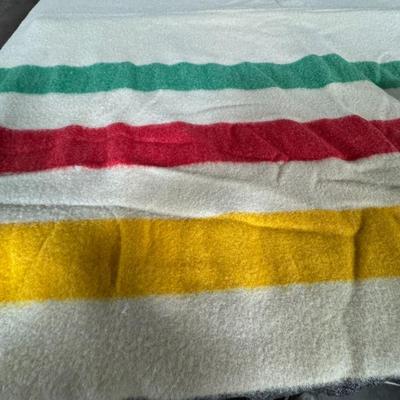
Point blankets and North America Point blankets are perhaps the Witney industry's most famous product. They were traded mainly with North America, where they came to have a cultural significance far beyond that of mere bed coverings. The origins of points Three and a half point blanket showing detail of the points. Three and a half point blanket showing detail of the points.Point blankets were so called because they had several short lines known as 'points' sewn or woven into one edge near a corner; the number of points on a blanket was intended to indicate its size and therefore its value [1]. The blankets were always made from wool and had one or more 'headings', or bands of colour, at either end but were produced in a great variety of colours and patterns over the years. Three and a half point Witney blanket made by Early's. Three and a half point Witney blanket made by Early's.Points were first used on blankets made for the domestic market in France during the 16th century; indeed the term 'point' is thought to come from the French verb 'empointer', meaning to make stitches on cloth. French traders had introduced the system to their blanket trade with North America by the 1690s. Blankets (typically of one to four points, in half-point steps) and other goods were traded with Native American peoples in exchange for a set number of beaver pelts, a fur in huge demand in Europe for the hat and clothing trade [2]. The number of points on a blanket was not originally intended to indicate that it should be traded for the same number of pelts, but that was often how they came to be used. Half points were worth either half a beaver skin, or an imperfect one [3]. The exchange rate of points-to-pelts varied from place to place and over time, however [4]. The North American market Early's advertising sign showing a point blanket trading between a Native American and an early merchant. Early's advertising sign showing a point blanket trading between a Native American and an early merchant.Many different groups of North American Native peoples prized point blankets for clothing and bedding because of their excellent insulating and water-repellent qualities. They were also boldly coloured and hard wearing without being too heavy. Colour was certainly an important factor for these discerning groups of consumers; different shades (and their intensity) often held spiritual meanings as well as acting as a personal or fashion statement. The manner of wearing a blanket could, according to tradition among some cultures, also denote status or a particular attitude or emotion of the wearer [5]. Far from being just practical household items, blankets had an established wider religious and cultural significance in this part of the World. 1970s advertising sign from Early's showing a hunter wearing a capote coat made from a point blanket. 1970s advertising sign from Early's showing a hunter wearing a capote coat made from a point blanket.Later, point blankets became named items in the treaty agreements made between Native peoples and the American and Canadian governments when the Northwest Territories were formed in 1870. The original inhabitants of the territories were compelled to give up title to their lands and in return were supposed to receive areas of land for their sole use, hunting and fishing rights and annually paid benefits that included farming equipment, education services and blankets for each man, woman and child [6]. Point blankets were also valued by the many European settlers in North America. They are still popular there and are in demand as furnishings, collectors' items, gifts, souvenirs and for making into clothing as well as continuing to be a traditional source of warmth and comfort on the bed. Although no longer made in Witney they are still produced in quantity elsewhere and this has long been the case: in the past they have been made by many different firms in countries such as Canada, the Czech Republic, England, India, New Zealand and the USA. Witney and the point blanket trade Point blankets and their forerunners seem to have been produced in Witney since the 17th century. The historian Dr Plot described the trade in his essay 'The Natural History of Oxfordshire' of 1667: '...of which Duffields and Blankets consists the chief Trade of Witney. These Duffields, so called from a Town in Brabant, where the Trade of them first began (whence it came to Colchester, Braintry, etc. and so to Witney) otherwise called Shags, and by the Merchants, Trucking-cloth; they make in pieces of about 30 yards long, and one Yard three-quarters broad, and dye them Red or Blue, which are the Colours that best please the Indians of Virginia and New-England, with whom the Merchants truck them for Bever, and other Furrs of several Beasts, etc., the use they have for them is to apparel themselves with them, their manner being to tear them into Gowns of about two Yards long, thrusting their Arms through two Holes made for that Purpose, and so wrapping the rest about them as we our Loose-coats. Our Merchants have abused them for many Years with so false Colours, that they will not hold their Gloss above a Months Wear; but there is an ingenious Person of Witney that has improved them much of late, by fixing upon them a true Blue Dye, having an Eye of Red, whereof as soon as the Indians shall be made sensible, and the disturbances now amongst them over, no doubt the Trade in those will be much advanced again' [7]. Witney had first supplied the Hudson's Bay Company (HBC) with woven goods as early as 1681 but the town did not become a major provider to it until the 1730s, when James Empson started receiving regular HBC orders [8]. One of the earliest definite records we have for the supply of point blankets comes in December 1779, when five hundred pairs of 'pointed' blankets were ordered by the HBC from the firm of Thomas Empson (James' son). The demand for points then seems to have increased rapidly until the fur trade reached its height in the early 19th century. Early's Witney Point blanket label showing the Native American symbol they adopted for their point blankets. Early's Witney Point blanket label showing the Native American symbol they adopted for their point blankets.Witney blanket makers including the Collier, Early, Empson and Marriott families received the lion's share of orders for points from the HBC to such an extent that 'point blankets' and 'Witney blankets' became used interchangeably for many years, although other English manufacturers also supplied the company [9]. Within the town there must have been competition among the blanket makers to secure the good custom of the HBC, not least because orders required that blankets were delivered between April and June so that ships could make their deliveries to North America unhindered by winter ice. In Witney this meant valuable employment during winter, which could be a thin time of the year: the home market decreed that summer was the busiest time for blanket making, in readiness for the increased demand during the colder months [10]. Witney manufacturers came to develop a high level of mutual cooperation, however: small master weavers often undertook sub-contracting work to help out larger firms that had secured big orders, and in the early 19th century the Colliers shared orders with Edward Early, John Early and Sons and the Marriotts. From the 1820s until at least the middle of the century, the Colliers and John Early and Sons seem to have been joint contractors to the HBC, sharing orders almost equally [11]. Women workers sewing points in by hand at Early's. Women workers sewing points in by hand at Early's.Witney continued to supply the HBC with point blankets until the 1920s, when a rivalry seems to have developed between it and Early's. As well as supplying point blankets to the HBC, Early's had also begun marketing 'Genuine Indian Point Blankets' under their own label in Winnipeg in 1878 and supplying points to non-HBC outlets. Other British blanket manufacturers followed their example. This competition led to a series of threatened law suits by both companies in a struggle to gain control of the North American market for 'genuine' point blankets, a situation which was not resolved until 1949, when the two companies agreed terms out of court [12]. Early's had changed from being a supplier for HBC to becoming their major competitor in the point blanket trade. A member of Early's staff seeing a roll of point blankets through one of the final stages in the production process. A member of Early's staff seeing a roll of point blankets through one of the final stages in the production process.The tradition of making of points carried on in some Witney blanket firms right up until their demise. In 1976 a new commemorative line marking the bicentennial of the United States of America was bought out by Early's. Smith and Philips' of Bridge Street Mill also produced point blankets for the HBC during the 20th century. 38 / 1369 -
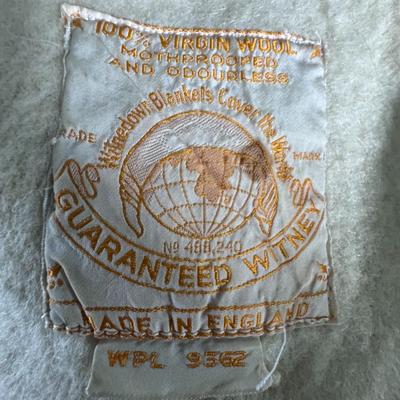
Point blankets and North America Point blankets are perhaps the Witney industry's most famous product. They were traded mainly with North America, where they came to have a cultural significance far beyond that of mere bed coverings. The origins of points Three and a half point blanket showing detail of the points. Three and a half point blanket showing detail of the points.Point blankets were so called because they had several short lines known as 'points' sewn or woven into one edge near a corner; the number of points on a blanket was intended to indicate its size and therefore its value [1]. The blankets were always made from wool and had one or more 'headings', or bands of colour, at either end but were produced in a great variety of colours and patterns over the years. Three and a half point Witney blanket made by Early's. Three and a half point Witney blanket made by Early's.Points were first used on blankets made for the domestic market in France during the 16th century; indeed the term 'point' is thought to come from the French verb 'empointer', meaning to make stitches on cloth. French traders had introduced the system to their blanket trade with North America by the 1690s. Blankets (typically of one to four points, in half-point steps) and other goods were traded with Native American peoples in exchange for a set number of beaver pelts, a fur in huge demand in Europe for the hat and clothing trade [2]. The number of points on a blanket was not originally intended to indicate that it should be traded for the same number of pelts, but that was often how they came to be used. Half points were worth either half a beaver skin, or an imperfect one [3]. The exchange rate of points-to-pelts varied from place to place and over time, however [4]. The North American market Early's advertising sign showing a point blanket trading between a Native American and an early merchant. Early's advertising sign showing a point blanket trading between a Native American and an early merchant.Many different groups of North American Native peoples prized point blankets for clothing and bedding because of their excellent insulating and water-repellent qualities. They were also boldly coloured and hard wearing without being too heavy. Colour was certainly an important factor for these discerning groups of consumers; different shades (and their intensity) often held spiritual meanings as well as acting as a personal or fashion statement. The manner of wearing a blanket could, according to tradition among some cultures, also denote status or a particular attitude or emotion of the wearer [5]. Far from being just practical household items, blankets had an established wider religious and cultural significance in this part of the World. 1970s advertising sign from Early's showing a hunter wearing a capote coat made from a point blanket. 1970s advertising sign from Early's showing a hunter wearing a capote coat made from a point blanket.Later, point blankets became named items in the treaty agreements made between Native peoples and the American and Canadian governments when the Northwest Territories were formed in 1870. The original inhabitants of the territories were compelled to give up title to their lands and in return were supposed to receive areas of land for their sole use, hunting and fishing rights and annually paid benefits that included farming equipment, education services and blankets for each man, woman and child [6]. Point blankets were also valued by the many European settlers in North America. They are still popular there and are in demand as furnishings, collectors' items, gifts, souvenirs and for making into clothing as well as continuing to be a traditional source of warmth and comfort on the bed. Although no longer made in Witney they are still produced in quantity elsewhere and this has long been the case: in the past they have been made by many different firms in countries such as Canada, the Czech Republic, England, India, New Zealand and the USA. Witney and the point blanket trade Point blankets and their forerunners seem to have been produced in Witney since the 17th century. The historian Dr Plot described the trade in his essay 'The Natural History of Oxfordshire' of 1667: '...of which Duffields and Blankets consists the chief Trade of Witney. These Duffields, so called from a Town in Brabant, where the Trade of them first began (whence it came to Colchester, Braintry, etc. and so to Witney) otherwise called Shags, and by the Merchants, Trucking-cloth; they make in pieces of about 30 yards long, and one Yard three-quarters broad, and dye them Red or Blue, which are the Colours that best please the Indians of Virginia and New-England, with whom the Merchants truck them for Bever, and other Furrs of several Beasts, etc., the use they have for them is to apparel themselves with them, their manner being to tear them into Gowns of about two Yards long, thrusting their Arms through two Holes made for that Purpose, and so wrapping the rest about them as we our Loose-coats. Our Merchants have abused them for many Years with so false Colours, that they will not hold their Gloss above a Months Wear; but there is an ingenious Person of Witney that has improved them much of late, by fixing upon them a true Blue Dye, having an Eye of Red, whereof as soon as the Indians shall be made sensible, and the disturbances now amongst them over, no doubt the Trade in those will be much advanced again' [7]. Witney had first supplied the Hudson's Bay Company (HBC) with woven goods as early as 1681 but the town did not become a major provider to it until the 1730s, when James Empson started receiving regular HBC orders [8]. One of the earliest definite records we have for the supply of point blankets comes in December 1779, when five hundred pairs of 'pointed' blankets were ordered by the HBC from the firm of Thomas Empson (James' son). The demand for points then seems to have increased rapidly until the fur trade reached its height in the early 19th century. Early's Witney Point blanket label showing the Native American symbol they adopted for their point blankets. Early's Witney Point blanket label showing the Native American symbol they adopted for their point blankets.Witney blanket makers including the Collier, Early, Empson and Marriott families received the lion's share of orders for points from the HBC to such an extent that 'point blankets' and 'Witney blankets' became used interchangeably for many years, although other English manufacturers also supplied the company [9]. Within the town there must have been competition among the blanket makers to secure the good custom of the HBC, not least because orders required that blankets were delivered between April and June so that ships could make their deliveries to North America unhindered by winter ice. In Witney this meant valuable employment during winter, which could be a thin time of the year: the home market decreed that summer was the busiest time for blanket making, in readiness for the increased demand during the colder months [10]. Witney manufacturers came to develop a high level of mutual cooperation, however: small master weavers often undertook sub-contracting work to help out larger firms that had secured big orders, and in the early 19th century the Colliers shared orders with Edward Early, John Early and Sons and the Marriotts. From the 1820s until at least the middle of the century, the Colliers and John Early and Sons seem to have been joint contractors to the HBC, sharing orders almost equally [11]. Women workers sewing points in by hand at Early's. Women workers sewing points in by hand at Early's.Witney continued to supply the HBC with point blankets until the 1920s, when a rivalry seems to have developed between it and Early's. As well as supplying point blankets to the HBC, Early's had also begun marketing 'Genuine Indian Point Blankets' under their own label in Winnipeg in 1878 and supplying points to non-HBC outlets. Other British blanket manufacturers followed their example. This competition led to a series of threatened law suits by both companies in a struggle to gain control of the North American market for 'genuine' point blankets, a situation which was not resolved until 1949, when the two companies agreed terms out of court [12]. Early's had changed from being a supplier for HBC to becoming their major competitor in the point blanket trade. A member of Early's staff seeing a roll of point blankets through one of the final stages in the production process. A member of Early's staff seeing a roll of point blankets through one of the final stages in the production process.The tradition of making of points carried on in some Witney blanket firms right up until their demise. In 1976 a new commemorative line marking the bicentennial of the United States of America was bought out by Early's. Smith and Philips' of Bridge Street Mill also produced point blankets for the HBC during the 20th century. 39 / 1369 -
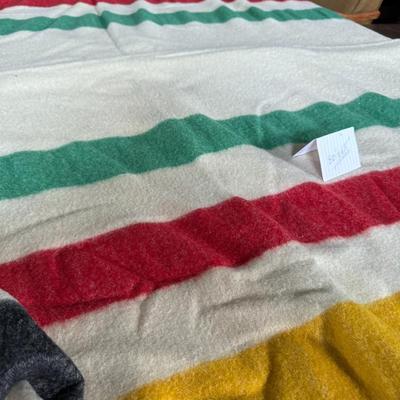
Point blankets and North America Point blankets are perhaps the Witney industry's most famous product. They were traded mainly with North America, where they came to have a cultural significance far beyond that of mere bed coverings. The origins of points Three and a half point blanket showing detail of the points. Three and a half point blanket showing detail of the points.Point blankets were so called because they had several short lines known as 'points' sewn or woven into one edge near a corner; the number of points on a blanket was intended to indicate its size and therefore its value [1]. The blankets were always made from wool and had one or more 'headings', or bands of colour, at either end but were produced in a great variety of colours and patterns over the years. Three and a half point Witney blanket made by Early's. Three and a half point Witney blanket made by Early's.Points were first used on blankets made for the domestic market in France during the 16th century; indeed the term 'point' is thought to come from the French verb 'empointer', meaning to make stitches on cloth. French traders had introduced the system to their blanket trade with North America by the 1690s. Blankets (typically of one to four points, in half-point steps) and other goods were traded with Native American peoples in exchange for a set number of beaver pelts, a fur in huge demand in Europe for the hat and clothing trade [2]. The number of points on a blanket was not originally intended to indicate that it should be traded for the same number of pelts, but that was often how they came to be used. Half points were worth either half a beaver skin, or an imperfect one [3]. The exchange rate of points-to-pelts varied from place to place and over time, however [4]. The North American market Early's advertising sign showing a point blanket trading between a Native American and an early merchant. Early's advertising sign showing a point blanket trading between a Native American and an early merchant.Many different groups of North American Native peoples prized point blankets for clothing and bedding because of their excellent insulating and water-repellent qualities. They were also boldly coloured and hard wearing without being too heavy. Colour was certainly an important factor for these discerning groups of consumers; different shades (and their intensity) often held spiritual meanings as well as acting as a personal or fashion statement. The manner of wearing a blanket could, according to tradition among some cultures, also denote status or a particular attitude or emotion of the wearer [5]. Far from being just practical household items, blankets had an established wider religious and cultural significance in this part of the World. 1970s advertising sign from Early's showing a hunter wearing a capote coat made from a point blanket. 1970s advertising sign from Early's showing a hunter wearing a capote coat made from a point blanket.Later, point blankets became named items in the treaty agreements made between Native peoples and the American and Canadian governments when the Northwest Territories were formed in 1870. The original inhabitants of the territories were compelled to give up title to their lands and in return were supposed to receive areas of land for their sole use, hunting and fishing rights and annually paid benefits that included farming equipment, education services and blankets for each man, woman and child [6]. Point blankets were also valued by the many European settlers in North America. They are still popular there and are in demand as furnishings, collectors' items, gifts, souvenirs and for making into clothing as well as continuing to be a traditional source of warmth and comfort on the bed. Although no longer made in Witney they are still produced in quantity elsewhere and this has long been the case: in the past they have been made by many different firms in countries such as Canada, the Czech Republic, England, India, New Zealand and the USA. Witney and the point blanket trade Point blankets and their forerunners seem to have been produced in Witney since the 17th century. The historian Dr Plot described the trade in his essay 'The Natural History of Oxfordshire' of 1667: '...of which Duffields and Blankets consists the chief Trade of Witney. These Duffields, so called from a Town in Brabant, where the Trade of them first began (whence it came to Colchester, Braintry, etc. and so to Witney) otherwise called Shags, and by the Merchants, Trucking-cloth; they make in pieces of about 30 yards long, and one Yard three-quarters broad, and dye them Red or Blue, which are the Colours that best please the Indians of Virginia and New-England, with whom the Merchants truck them for Bever, and other Furrs of several Beasts, etc., the use they have for them is to apparel themselves with them, their manner being to tear them into Gowns of about two Yards long, thrusting their Arms through two Holes made for that Purpose, and so wrapping the rest about them as we our Loose-coats. Our Merchants have abused them for many Years with so false Colours, that they will not hold their Gloss above a Months Wear; but there is an ingenious Person of Witney that has improved them much of late, by fixing upon them a true Blue Dye, having an Eye of Red, whereof as soon as the Indians shall be made sensible, and the disturbances now amongst them over, no doubt the Trade in those will be much advanced again' [7]. Witney had first supplied the Hudson's Bay Company (HBC) with woven goods as early as 1681 but the town did not become a major provider to it until the 1730s, when James Empson started receiving regular HBC orders [8]. One of the earliest definite records we have for the supply of point blankets comes in December 1779, when five hundred pairs of 'pointed' blankets were ordered by the HBC from the firm of Thomas Empson (James' son). The demand for points then seems to have increased rapidly until the fur trade reached its height in the early 19th century. Early's Witney Point blanket label showing the Native American symbol they adopted for their point blankets. Early's Witney Point blanket label showing the Native American symbol they adopted for their point blankets.Witney blanket makers including the Collier, Early, Empson and Marriott families received the lion's share of orders for points from the HBC to such an extent that 'point blankets' and 'Witney blankets' became used interchangeably for many years, although other English manufacturers also supplied the company [9]. Within the town there must have been competition among the blanket makers to secure the good custom of the HBC, not least because orders required that blankets were delivered between April and June so that ships could make their deliveries to North America unhindered by winter ice. In Witney this meant valuable employment during winter, which could be a thin time of the year: the home market decreed that summer was the busiest time for blanket making, in readiness for the increased demand during the colder months [10]. Witney manufacturers came to develop a high level of mutual cooperation, however: small master weavers often undertook sub-contracting work to help out larger firms that had secured big orders, and in the early 19th century the Colliers shared orders with Edward Early, John Early and Sons and the Marriotts. From the 1820s until at least the middle of the century, the Colliers and John Early and Sons seem to have been joint contractors to the HBC, sharing orders almost equally [11]. Women workers sewing points in by hand at Early's. Women workers sewing points in by hand at Early's.Witney continued to supply the HBC with point blankets until the 1920s, when a rivalry seems to have developed between it and Early's. As well as supplying point blankets to the HBC, Early's had also begun marketing 'Genuine Indian Point Blankets' under their own label in Winnipeg in 1878 and supplying points to non-HBC outlets. Other British blanket manufacturers followed their example. This competition led to a series of threatened law suits by both companies in a struggle to gain control of the North American market for 'genuine' point blankets, a situation which was not resolved until 1949, when the two companies agreed terms out of court [12]. Early's had changed from being a supplier for HBC to becoming their major competitor in the point blanket trade. A member of Early's staff seeing a roll of point blankets through one of the final stages in the production process. A member of Early's staff seeing a roll of point blankets through one of the final stages in the production process.The tradition of making of points carried on in some Witney blanket firms right up until their demise. In 1976 a new commemorative line marking the bicentennial of the United States of America was bought out by Early's. Smith and Philips' of Bridge Street Mill also produced point blankets for the HBC during the 20th century. 40 / 1369 -
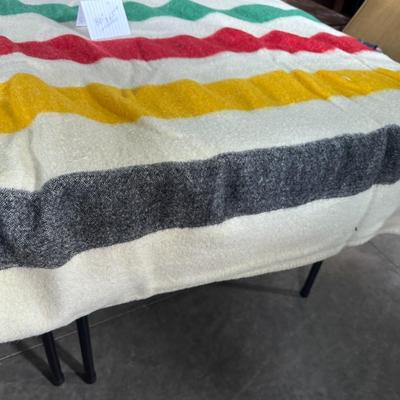
Point blankets and North America Point blankets are perhaps the Witney industry's most famous product. They were traded mainly with North America, where they came to have a cultural significance far beyond that of mere bed coverings. The origins of points Three and a half point blanket showing detail of the points. Three and a half point blanket showing detail of the points.Point blankets were so called because they had several short lines known as 'points' sewn or woven into one edge near a corner; the number of points on a blanket was intended to indicate its size and therefore its value [1]. The blankets were always made from wool and had one or more 'headings', or bands of colour, at either end but were produced in a great variety of colours and patterns over the years. Three and a half point Witney blanket made by Early's. Three and a half point Witney blanket made by Early's.Points were first used on blankets made for the domestic market in France during the 16th century; indeed the term 'point' is thought to come from the French verb 'empointer', meaning to make stitches on cloth. French traders had introduced the system to their blanket trade with North America by the 1690s. Blankets (typically of one to four points, in half-point steps) and other goods were traded with Native American peoples in exchange for a set number of beaver pelts, a fur in huge demand in Europe for the hat and clothing trade [2]. The number of points on a blanket was not originally intended to indicate that it should be traded for the same number of pelts, but that was often how they came to be used. Half points were worth either half a beaver skin, or an imperfect one [3]. The exchange rate of points-to-pelts varied from place to place and over time, however [4]. The North American market Early's advertising sign showing a point blanket trading between a Native American and an early merchant. Early's advertising sign showing a point blanket trading between a Native American and an early merchant.Many different groups of North American Native peoples prized point blankets for clothing and bedding because of their excellent insulating and water-repellent qualities. They were also boldly coloured and hard wearing without being too heavy. Colour was certainly an important factor for these discerning groups of consumers; different shades (and their intensity) often held spiritual meanings as well as acting as a personal or fashion statement. The manner of wearing a blanket could, according to tradition among some cultures, also denote status or a particular attitude or emotion of the wearer [5]. Far from being just practical household items, blankets had an established wider religious and cultural significance in this part of the World. 1970s advertising sign from Early's showing a hunter wearing a capote coat made from a point blanket. 1970s advertising sign from Early's showing a hunter wearing a capote coat made from a point blanket.Later, point blankets became named items in the treaty agreements made between Native peoples and the American and Canadian governments when the Northwest Territories were formed in 1870. The original inhabitants of the territories were compelled to give up title to their lands and in return were supposed to receive areas of land for their sole use, hunting and fishing rights and annually paid benefits that included farming equipment, education services and blankets for each man, woman and child [6]. Point blankets were also valued by the many European settlers in North America. They are still popular there and are in demand as furnishings, collectors' items, gifts, souvenirs and for making into clothing as well as continuing to be a traditional source of warmth and comfort on the bed. Although no longer made in Witney they are still produced in quantity elsewhere and this has long been the case: in the past they have been made by many different firms in countries such as Canada, the Czech Republic, England, India, New Zealand and the USA. Witney and the point blanket trade Point blankets and their forerunners seem to have been produced in Witney since the 17th century. The historian Dr Plot described the trade in his essay 'The Natural History of Oxfordshire' of 1667: '...of which Duffields and Blankets consists the chief Trade of Witney. These Duffields, so called from a Town in Brabant, where the Trade of them first began (whence it came to Colchester, Braintry, etc. and so to Witney) otherwise called Shags, and by the Merchants, Trucking-cloth; they make in pieces of about 30 yards long, and one Yard three-quarters broad, and dye them Red or Blue, which are the Colours that best please the Indians of Virginia and New-England, with whom the Merchants truck them for Bever, and other Furrs of several Beasts, etc., the use they have for them is to apparel themselves with them, their manner being to tear them into Gowns of about two Yards long, thrusting their Arms through two Holes made for that Purpose, and so wrapping the rest about them as we our Loose-coats. Our Merchants have abused them for many Years with so false Colours, that they will not hold their Gloss above a Months Wear; but there is an ingenious Person of Witney that has improved them much of late, by fixing upon them a true Blue Dye, having an Eye of Red, whereof as soon as the Indians shall be made sensible, and the disturbances now amongst them over, no doubt the Trade in those will be much advanced again' [7]. Witney had first supplied the Hudson's Bay Company (HBC) with woven goods as early as 1681 but the town did not become a major provider to it until the 1730s, when James Empson started receiving regular HBC orders [8]. One of the earliest definite records we have for the supply of point blankets comes in December 1779, when five hundred pairs of 'pointed' blankets were ordered by the HBC from the firm of Thomas Empson (James' son). The demand for points then seems to have increased rapidly until the fur trade reached its height in the early 19th century. Early's Witney Point blanket label showing the Native American symbol they adopted for their point blankets. Early's Witney Point blanket label showing the Native American symbol they adopted for their point blankets.Witney blanket makers including the Collier, Early, Empson and Marriott families received the lion's share of orders for points from the HBC to such an extent that 'point blankets' and 'Witney blankets' became used interchangeably for many years, although other English manufacturers also supplied the company [9]. Within the town there must have been competition among the blanket makers to secure the good custom of the HBC, not least because orders required that blankets were delivered between April and June so that ships could make their deliveries to North America unhindered by winter ice. In Witney this meant valuable employment during winter, which could be a thin time of the year: the home market decreed that summer was the busiest time for blanket making, in readiness for the increased demand during the colder months [10]. Witney manufacturers came to develop a high level of mutual cooperation, however: small master weavers often undertook sub-contracting work to help out larger firms that had secured big orders, and in the early 19th century the Colliers shared orders with Edward Early, John Early and Sons and the Marriotts. From the 1820s until at least the middle of the century, the Colliers and John Early and Sons seem to have been joint contractors to the HBC, sharing orders almost equally [11]. Women workers sewing points in by hand at Early's. Women workers sewing points in by hand at Early's.Witney continued to supply the HBC with point blankets until the 1920s, when a rivalry seems to have developed between it and Early's. As well as supplying point blankets to the HBC, Early's had also begun marketing 'Genuine Indian Point Blankets' under their own label in Winnipeg in 1878 and supplying points to non-HBC outlets. Other British blanket manufacturers followed their example. This competition led to a series of threatened law suits by both companies in a struggle to gain control of the North American market for 'genuine' point blankets, a situation which was not resolved until 1949, when the two companies agreed terms out of court [12]. Early's had changed from being a supplier for HBC to becoming their major competitor in the point blanket trade. A member of Early's staff seeing a roll of point blankets through one of the final stages in the production process. A member of Early's staff seeing a roll of point blankets through one of the final stages in the production process.The tradition of making of points carried on in some Witney blanket firms right up until their demise. In 1976 a new commemorative line marking the bicentennial of the United States of America was bought out by Early's. Smith and Philips' of Bridge Street Mill also produced point blankets for the HBC during the 20th century. 41 / 1369 -

Lyon's primitive stoneware jug. Here's some information about this type of item: Description: It's a classic, ovoid-shaped jug made of stoneware, likely with a salt glaze, given its appearance and the commonality of this finish on such pieces. Historical Use: These jugs were commonly used in the 18th and 19th centuries for storing and transporting various liquids, including water, milk, cider, and spirits like whiskey. 42 / 1369 -
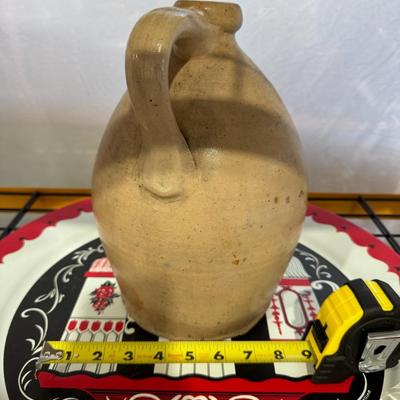
Lyon's primitive stoneware jug. Here's some information about this type of item: Description: It's a classic, ovoid-shaped jug made of stoneware, likely with a salt glaze, given its appearance and the commonality of this finish on such pieces. Historical Use: These jugs were commonly used in the 18th and 19th centuries for storing and transporting various liquids, including water, milk, cider, and spirits like whiskey. 43 / 1369 -
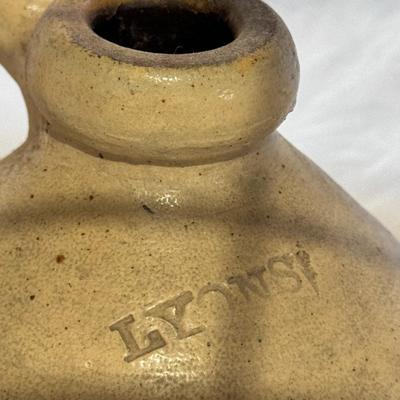
Lyon's primitive stoneware jug. Here's some information about this type of item: Description: It's a classic, ovoid-shaped jug made of stoneware, likely with a salt glaze, given its appearance and the commonality of this finish on such pieces. Historical Use: These jugs were commonly used in the 18th and 19th centuries for storing and transporting various liquids, including water, milk, cider, and spirits like whiskey. 44 / 1369 -
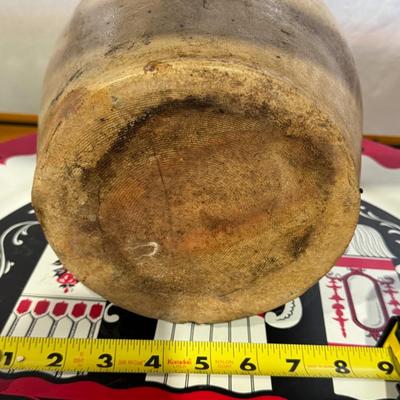
Lyon's primitive stoneware jug. Here's some information about this type of item: Description: It's a classic, ovoid-shaped jug made of stoneware, likely with a salt glaze, given its appearance and the commonality of this finish on such pieces. Historical Use: These jugs were commonly used in the 18th and 19th centuries for storing and transporting various liquids, including water, milk, cider, and spirits like whiskey. 45 / 1369 -
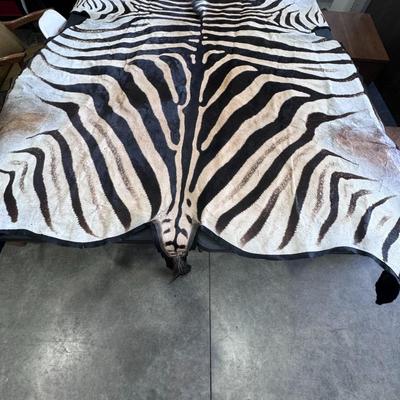
Very large buck Zebra hide, felt back. Zebra was taken by late owner of Gander mountain. Single owner, stored correctly, non-smoking. Authenticity: Genuine zebra hide rugs are unique, with no two stripe patterns being identical, similar to human fingerprints. Be aware that fake zebra rugs, often made from dyed cowhides, are also available in the market, so it's important to verify authenticity when purchasing. Ethical Sourcing: Reputable suppliers emphasize ethical sourcing, often acquiring hides from regulated wildlife programs and game reserves in countries like South Africa and Namibia, where zebra populations are not endangered. Grades and Quality: Zebra hides are graded based on their quality and the presence of natural flaws or scars, which are a reflection of the animal's life in the wild. Trophy Grade and Grade A hides are considered the finest with minimal imperfections, 50 / 1369 -
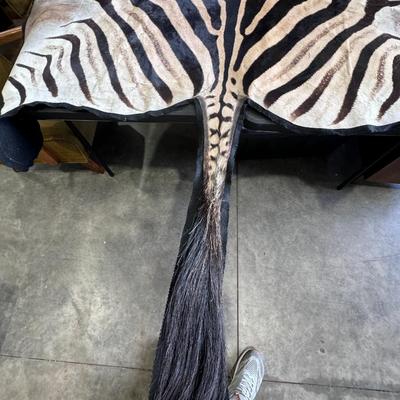
Very large buck Zebra hide, felt back. Zebra was taken by late owner of Gander mountain. Single owner, stored correctly, non-smoking. Authenticity: Genuine zebra hide rugs are unique, with no two stripe patterns being identical, similar to human fingerprints. Be aware that fake zebra rugs, often made from dyed cowhides, are also available in the market, so it's important to verify authenticity when purchasing. Ethical Sourcing: Reputable suppliers emphasize ethical sourcing, often acquiring hides from regulated wildlife programs and game reserves in countries like South Africa and Namibia, where zebra populations are not endangered. Grades and Quality: Zebra hides are graded based on their quality and the presence of natural flaws or scars, which are a reflection of the animal's life in the wild. Trophy Grade and Grade A hides are considered the finest with minimal imperfections, 51 / 1369 -

Very large buck Zebra hide, felt back. Zebra was taken by late owner of Gander mountain. Single owner, stored correctly, non-smoking. Authenticity: Genuine zebra hide rugs are unique, with no two stripe patterns being identical, similar to human fingerprints. Be aware that fake zebra rugs, often made from dyed cowhides, are also available in the market, so it's important to verify authenticity when purchasing. Ethical Sourcing: Reputable suppliers emphasize ethical sourcing, often acquiring hides from regulated wildlife programs and game reserves in countries like South Africa and Namibia, where zebra populations are not endangered. Grades and Quality: Zebra hides are graded based on their quality and the presence of natural flaws or scars, which are a reflection of the animal's life in the wild. Trophy Grade and Grade A hides are considered the finest with minimal imperfections, 52 / 1369 -
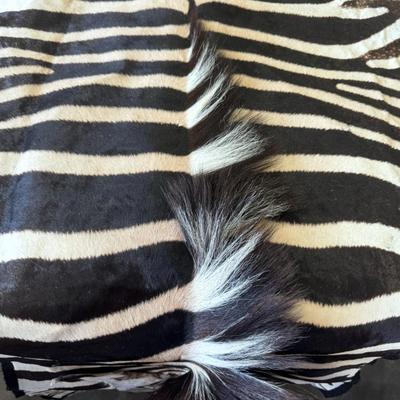
Very large buck Zebra hide, felt back. Zebra was taken by late owner of Gander mountain. Single owner, stored correctly, non-smoking. Authenticity: Genuine zebra hide rugs are unique, with no two stripe patterns being identical, similar to human fingerprints. Be aware that fake zebra rugs, often made from dyed cowhides, are also available in the market, so it's important to verify authenticity when purchasing. Ethical Sourcing: Reputable suppliers emphasize ethical sourcing, often acquiring hides from regulated wildlife programs and game reserves in countries like South Africa and Namibia, where zebra populations are not endangered. Grades and Quality: Zebra hides are graded based on their quality and the presence of natural flaws or scars, which are a reflection of the animal's life in the wild. Trophy Grade and Grade A hides are considered the finest with minimal imperfections, 53 / 1369 -
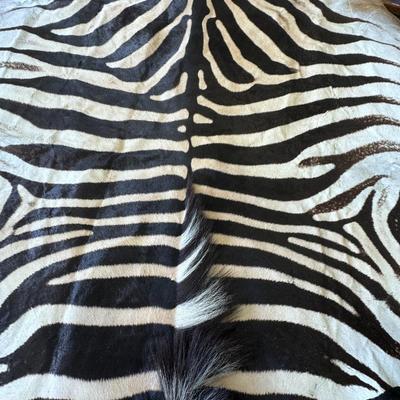
Very large buck Zebra hide, felt back. Zebra was taken by late owner of Gander mountain. Single owner, stored correctly, non-smoking. Authenticity: Genuine zebra hide rugs are unique, with no two stripe patterns being identical, similar to human fingerprints. Be aware that fake zebra rugs, often made from dyed cowhides, are also available in the market, so it's important to verify authenticity when purchasing. Ethical Sourcing: Reputable suppliers emphasize ethical sourcing, often acquiring hides from regulated wildlife programs and game reserves in countries like South Africa and Namibia, where zebra populations are not endangered. Grades and Quality: Zebra hides are graded based on their quality and the presence of natural flaws or scars, which are a reflection of the animal's life in the wild. Trophy Grade and Grade A hides are considered the finest with minimal imperfections, 54 / 1369 -
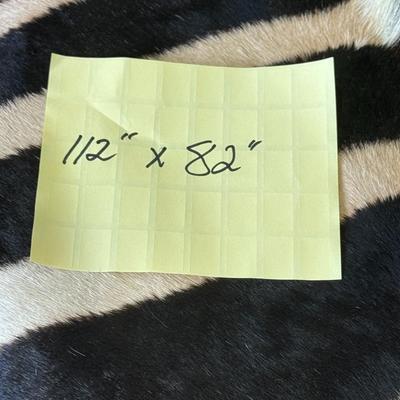
Very large buck Zebra hide, felt back. Zebra was taken by late owner of Gander mountain. Single owner, stored correctly, non-smoking. Authenticity: Genuine zebra hide rugs are unique, with no two stripe patterns being identical, similar to human fingerprints. Be aware that fake zebra rugs, often made from dyed cowhides, are also available in the market, so it's important to verify authenticity when purchasing. Ethical Sourcing: Reputable suppliers emphasize ethical sourcing, often acquiring hides from regulated wildlife programs and game reserves in countries like South Africa and Namibia, where zebra populations are not endangered. Grades and Quality: Zebra hides are graded based on their quality and the presence of natural flaws or scars, which are a reflection of the animal's life in the wild. Trophy Grade and Grade A hides are considered the finest with minimal imperfections, 55 / 1369 -
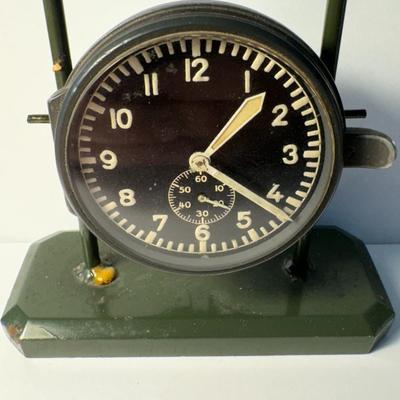
Runs good Luftwaffe Betriebsuhr, also known as a Stationsuhr or Funkeruhr, which was an operational clock used by the German military, particularly the Luftwaffe, during World War II. Here's more information about it: Purpose & Usage: These clocks were essential for synchronizing time in radio and communication stations, including those used by the Army (Heer), Air Force (Luftwaffe), and Navy (Kriegsmarine). Manufacturer: The most prominent manufacturer was Junghans, but other companies like Kienzle, Tobias Bäurle & Söhne, and Köhler & Co. also produced them. Features: They were typically mechanical timepieces with an 8-day winding mechanism and often featured a 6 cm diameter face with a separate seconds hand at the 6 o'clock position. Design & Materials: The clocks were housed in hinged casings, often placed in wooden bases, and varied in appearance and materials depending on the manufacturer and period of production, with early models featuring chromed parts and later ones often painted in military-specific colors like Luftwaffe grey. Collectibility: These clocks are considered collectible historical artifacts due to their association with WWII German military history, especially by collectors of military memorabilia 61 / 1369 -
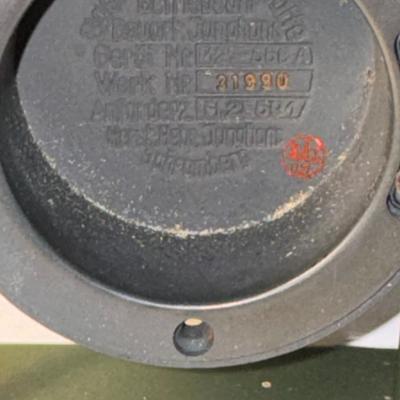
Runs good Luftwaffe Betriebsuhr, also known as a Stationsuhr or Funkeruhr, which was an operational clock used by the German military, particularly the Luftwaffe, during World War II. Here's more information about it: Purpose & Usage: These clocks were essential for synchronizing time in radio and communication stations, including those used by the Army (Heer), Air Force (Luftwaffe), and Navy (Kriegsmarine). Manufacturer: The most prominent manufacturer was Junghans, but other companies like Kienzle, Tobias Bäurle & Söhne, and Köhler & Co. also produced them. Features: They were typically mechanical timepieces with an 8-day winding mechanism and often featured a 6 cm diameter face with a separate seconds hand at the 6 o'clock position. Design & Materials: The clocks were housed in hinged casings, often placed in wooden bases, and varied in appearance and materials depending on the manufacturer and period of production, with early models featuring chromed parts and later ones often painted in military-specific colors like Luftwaffe grey. Collectibility: These clocks are considered collectible historical artifacts due to their association with WWII German military history, especially by collectors of military memorabilia 62 / 1369 -
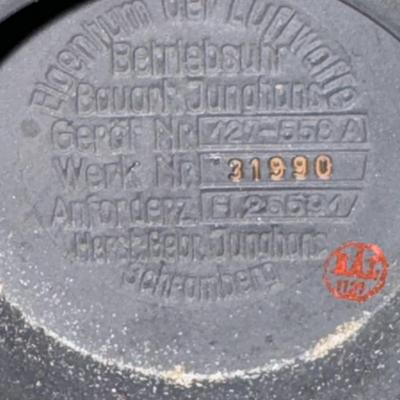
Runs good Luftwaffe Betriebsuhr, also known as a Stationsuhr or Funkeruhr, which was an operational clock used by the German military, particularly the Luftwaffe, during World War II. Here's more information about it: Purpose & Usage: These clocks were essential for synchronizing time in radio and communication stations, including those used by the Army (Heer), Air Force (Luftwaffe), and Navy (Kriegsmarine). Manufacturer: The most prominent manufacturer was Junghans, but other companies like Kienzle, Tobias Bäurle & Söhne, and Köhler & Co. also produced them. Features: They were typically mechanical timepieces with an 8-day winding mechanism and often featured a 6 cm diameter face with a separate seconds hand at the 6 o'clock position. Design & Materials: The clocks were housed in hinged casings, often placed in wooden bases, and varied in appearance and materials depending on the manufacturer and period of production, with early models featuring chromed parts and later ones often painted in military-specific colors like Luftwaffe grey. Collectibility: These clocks are considered collectible historical artifacts due to their association with WWII German military history, especially by collectors of military memorabilia 63 / 1369 -
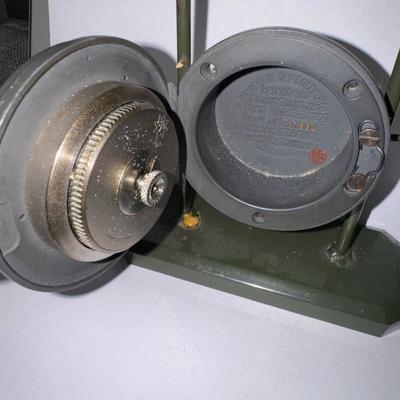
Runs good Luftwaffe Betriebsuhr, also known as a Stationsuhr or Funkeruhr, which was an operational clock used by the German military, particularly the Luftwaffe, during World War II. Here's more information about it: Purpose & Usage: These clocks were essential for synchronizing time in radio and communication stations, including those used by the Army (Heer), Air Force (Luftwaffe), and Navy (Kriegsmarine). Manufacturer: The most prominent manufacturer was Junghans, but other companies like Kienzle, Tobias Bäurle & Söhne, and Köhler & Co. also produced them. Features: They were typically mechanical timepieces with an 8-day winding mechanism and often featured a 6 cm diameter face with a separate seconds hand at the 6 o'clock position. Design & Materials: The clocks were housed in hinged casings, often placed in wooden bases, and varied in appearance and materials depending on the manufacturer and period of production, with early models featuring chromed parts and later ones often painted in military-specific colors like Luftwaffe grey. Collectibility: These clocks are considered collectible historical artifacts due to their association with WWII German military history, especially by collectors of military memorabilia 64 / 1369 -
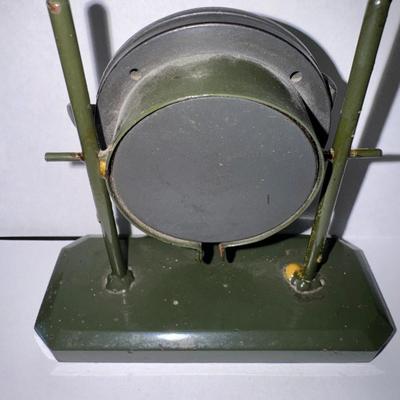
Runs good Luftwaffe Betriebsuhr, also known as a Stationsuhr or Funkeruhr, which was an operational clock used by the German military, particularly the Luftwaffe, during World War II. Here's more information about it: Purpose & Usage: These clocks were essential for synchronizing time in radio and communication stations, including those used by the Army (Heer), Air Force (Luftwaffe), and Navy (Kriegsmarine). Manufacturer: The most prominent manufacturer was Junghans, but other companies like Kienzle, Tobias Bäurle & Söhne, and Köhler & Co. also produced them. Features: They were typically mechanical timepieces with an 8-day winding mechanism and often featured a 6 cm diameter face with a separate seconds hand at the 6 o'clock position. Design & Materials: The clocks were housed in hinged casings, often placed in wooden bases, and varied in appearance and materials depending on the manufacturer and period of production, with early models featuring chromed parts and later ones often painted in military-specific colors like Luftwaffe grey. Collectibility: These clocks are considered collectible historical artifacts due to their association with WWII German military history, especially by collectors of military memorabilia 65 / 1369 -
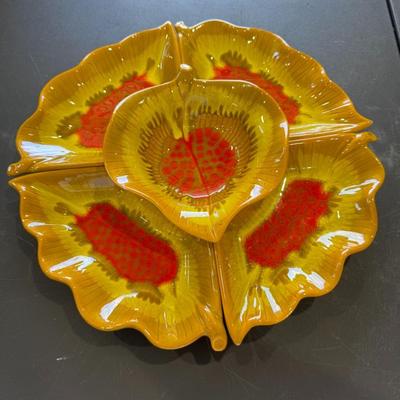
The image shows a vintage California Pottery Lazy Susan serving set, characterized by its vibrant orange, yellow, and red drip glaze and leaf-shaped ceramic dishes. Here's more information about this type of piece: Mid-Century Modern (MCM) Style: This set is a prime example of Mid-Century Modern design, known for its bold colors and organic shapes, popular in the 1960s and 1970s. Maker: While often unmarked, similar pieces are associated with California pottery companies like Deforest of California and California Originals. Some sets might even have specific model numbers like "RL70" stamped on them. Components: The set typically includes a central bowl surrounded by four or more curved, leaf-shaped dishes, all resting on a rotating wooden lazy Susan base. Functionality: Designed for entertaining, these sets are commonly used for serving snacks, chips and dip, relish, or creating a small charcuterie spread. 71 / 1369 -
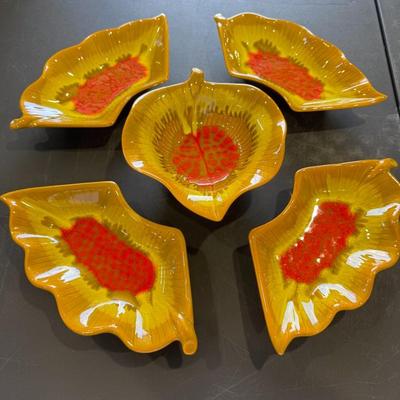
The image shows a vintage California Pottery Lazy Susan serving set, characterized by its vibrant orange, yellow, and red drip glaze and leaf-shaped ceramic dishes. Here's more information about this type of piece: Mid-Century Modern (MCM) Style: This set is a prime example of Mid-Century Modern design, known for its bold colors and organic shapes, popular in the 1960s and 1970s. Maker: While often unmarked, similar pieces are associated with California pottery companies like Deforest of California and California Originals. Some sets might even have specific model numbers like "RL70" stamped on them. Components: The set typically includes a central bowl surrounded by four or more curved, leaf-shaped dishes, all resting on a rotating wooden lazy Susan base. Functionality: Designed for entertaining, these sets are commonly used for serving snacks, chips and dip, relish, or creating a small charcuterie spread. 72 / 1369 -
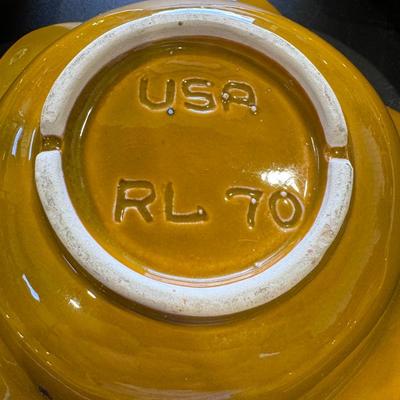
The image shows a vintage California Pottery Lazy Susan serving set, characterized by its vibrant orange, yellow, and red drip glaze and leaf-shaped ceramic dishes. Here's more information about this type of piece: Mid-Century Modern (MCM) Style: This set is a prime example of Mid-Century Modern design, known for its bold colors and organic shapes, popular in the 1960s and 1970s. Maker: While often unmarked, similar pieces are associated with California pottery companies like Deforest of California and California Originals. Some sets might even have specific model numbers like "RL70" stamped on them. Components: The set typically includes a central bowl surrounded by four or more curved, leaf-shaped dishes, all resting on a rotating wooden lazy Susan base. Functionality: Designed for entertaining, these sets are commonly used for serving snacks, chips and dip, relish, or creating a small charcuterie spread. 73 / 1369 -
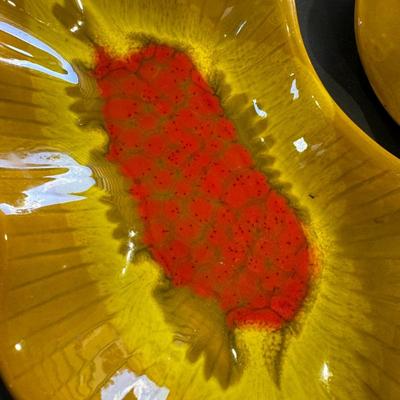
The image shows a vintage California Pottery Lazy Susan serving set, characterized by its vibrant orange, yellow, and red drip glaze and leaf-shaped ceramic dishes. Here's more information about this type of piece: Mid-Century Modern (MCM) Style: This set is a prime example of Mid-Century Modern design, known for its bold colors and organic shapes, popular in the 1960s and 1970s. Maker: While often unmarked, similar pieces are associated with California pottery companies like Deforest of California and California Originals. Some sets might even have specific model numbers like "RL70" stamped on them. Components: The set typically includes a central bowl surrounded by four or more curved, leaf-shaped dishes, all resting on a rotating wooden lazy Susan base. Functionality: Designed for entertaining, these sets are commonly used for serving snacks, chips and dip, relish, or creating a small charcuterie spread. 74 / 1369 -
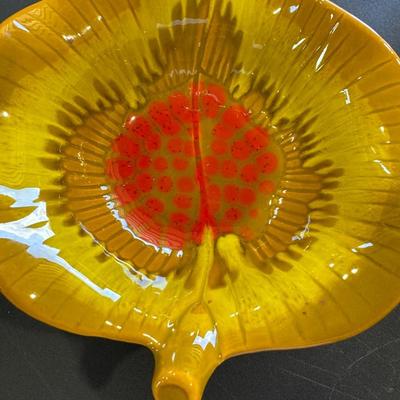
The image shows a vintage California Pottery Lazy Susan serving set, characterized by its vibrant orange, yellow, and red drip glaze and leaf-shaped ceramic dishes. Here's more information about this type of piece: Mid-Century Modern (MCM) Style: This set is a prime example of Mid-Century Modern design, known for its bold colors and organic shapes, popular in the 1960s and 1970s. Maker: While often unmarked, similar pieces are associated with California pottery companies like Deforest of California and California Originals. Some sets might even have specific model numbers like "RL70" stamped on them. Components: The set typically includes a central bowl surrounded by four or more curved, leaf-shaped dishes, all resting on a rotating wooden lazy Susan base. Functionality: Designed for entertaining, these sets are commonly used for serving snacks, chips and dip, relish, or creating a small charcuterie spread. 75 / 1369 -
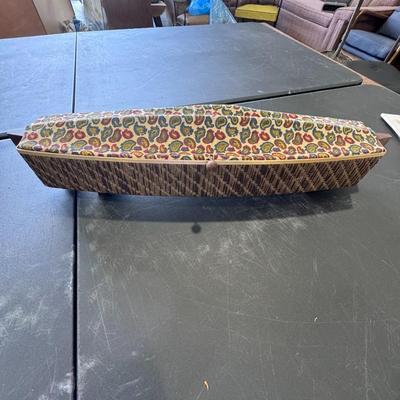
The item in the image is a Vintage Salton Hotray Automatic Bread or Bun Warmer. This particular model is likely from the 1960s or 1970s, identifiable by its distinct woven or basket-like exterior and the iconic paisley patterned fabric lining on the lid. Key features and information: Function: Designed to keep bread, buns, rolls, or other baked goods warm during meals or gatherings. Brand & Era: Manufactured by Salton, a well-known brand for kitchen appliances, particularly hot trays, during the mid-20th century. Design: Features a heated base (the "Hotray" element) and a hinged lid often lined with a vibrant fabric, like the paisley pattern seen here. Operation: These electric warmers simply plug in to heat, and some models could be unplugged and retain heat for a period due to their design. 83 / 1369 -
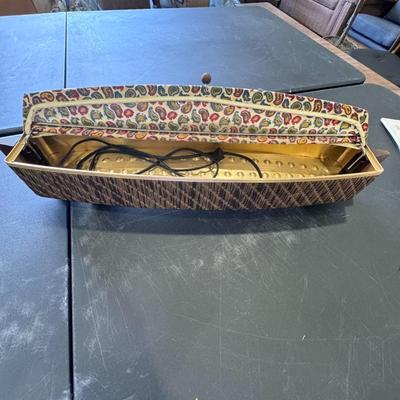
The item in the image is a Vintage Salton Hotray Automatic Bread or Bun Warmer. This particular model is likely from the 1960s or 1970s, identifiable by its distinct woven or basket-like exterior and the iconic paisley patterned fabric lining on the lid. Key features and information: Function: Designed to keep bread, buns, rolls, or other baked goods warm during meals or gatherings. Brand & Era: Manufactured by Salton, a well-known brand for kitchen appliances, particularly hot trays, during the mid-20th century. Design: Features a heated base (the "Hotray" element) and a hinged lid often lined with a vibrant fabric, like the paisley pattern seen here. Operation: These electric warmers simply plug in to heat, and some models could be unplugged and retain heat for a period due to their design. 84 / 1369 -
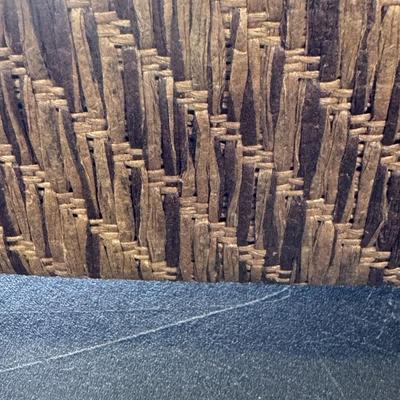
The item in the image is a Vintage Salton Hotray Automatic Bread or Bun Warmer. This particular model is likely from the 1960s or 1970s, identifiable by its distinct woven or basket-like exterior and the iconic paisley patterned fabric lining on the lid. Key features and information: Function: Designed to keep bread, buns, rolls, or other baked goods warm during meals or gatherings. Brand & Era: Manufactured by Salton, a well-known brand for kitchen appliances, particularly hot trays, during the mid-20th century. Design: Features a heated base (the "Hotray" element) and a hinged lid often lined with a vibrant fabric, like the paisley pattern seen here. Operation: These electric warmers simply plug in to heat, and some models could be unplugged and retain heat for a period due to their design. 85 / 1369 -
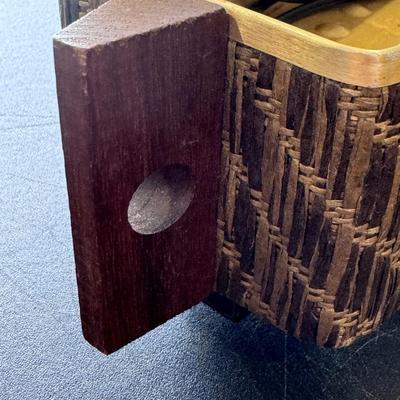
The item in the image is a Vintage Salton Hotray Automatic Bread or Bun Warmer. This particular model is likely from the 1960s or 1970s, identifiable by its distinct woven or basket-like exterior and the iconic paisley patterned fabric lining on the lid. Key features and information: Function: Designed to keep bread, buns, rolls, or other baked goods warm during meals or gatherings. Brand & Era: Manufactured by Salton, a well-known brand for kitchen appliances, particularly hot trays, during the mid-20th century. Design: Features a heated base (the "Hotray" element) and a hinged lid often lined with a vibrant fabric, like the paisley pattern seen here. Operation: These electric warmers simply plug in to heat, and some models could be unplugged and retain heat for a period due to their design. 86 / 1369 -
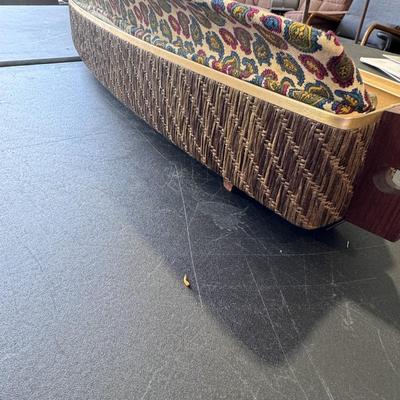
The item in the image is a Vintage Salton Hotray Automatic Bread or Bun Warmer. This particular model is likely from the 1960s or 1970s, identifiable by its distinct woven or basket-like exterior and the iconic paisley patterned fabric lining on the lid. Key features and information: Function: Designed to keep bread, buns, rolls, or other baked goods warm during meals or gatherings. Brand & Era: Manufactured by Salton, a well-known brand for kitchen appliances, particularly hot trays, during the mid-20th century. Design: Features a heated base (the "Hotray" element) and a hinged lid often lined with a vibrant fabric, like the paisley pattern seen here. Operation: These electric warmers simply plug in to heat, and some models could be unplugged and retain heat for a period due to their design. 87 / 1369 -
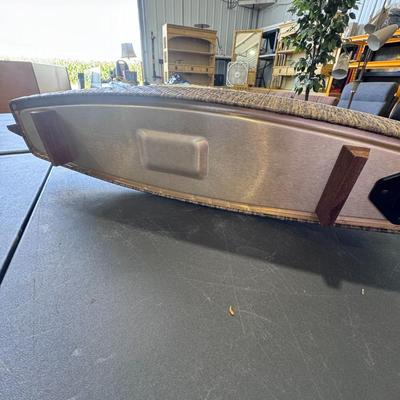
The item in the image is a Vintage Salton Hotray Automatic Bread or Bun Warmer. This particular model is likely from the 1960s or 1970s, identifiable by its distinct woven or basket-like exterior and the iconic paisley patterned fabric lining on the lid. Key features and information: Function: Designed to keep bread, buns, rolls, or other baked goods warm during meals or gatherings. Brand & Era: Manufactured by Salton, a well-known brand for kitchen appliances, particularly hot trays, during the mid-20th century. Design: Features a heated base (the "Hotray" element) and a hinged lid often lined with a vibrant fabric, like the paisley pattern seen here. Operation: These electric warmers simply plug in to heat, and some models could be unplugged and retain heat for a period due to their design. 88 / 1369 -
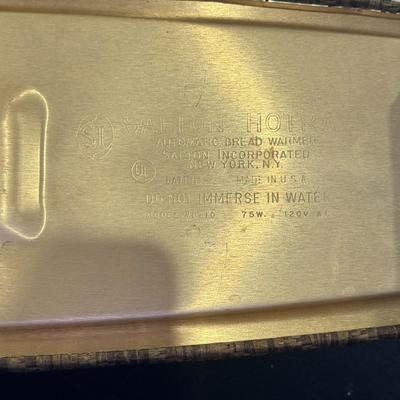
The item in the image is a Vintage Salton Hotray Automatic Bread or Bun Warmer. This particular model is likely from the 1960s or 1970s, identifiable by its distinct woven or basket-like exterior and the iconic paisley patterned fabric lining on the lid. Key features and information: Function: Designed to keep bread, buns, rolls, or other baked goods warm during meals or gatherings. Brand & Era: Manufactured by Salton, a well-known brand for kitchen appliances, particularly hot trays, during the mid-20th century. Design: Features a heated base (the "Hotray" element) and a hinged lid often lined with a vibrant fabric, like the paisley pattern seen here. Operation: These electric warmers simply plug in to heat, and some models could be unplugged and retain heat for a period due to their design. 89 / 1369 -
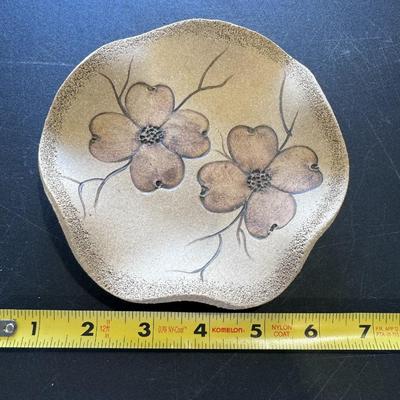
Here are some details about the item: Design: The dish showcases a distinct floral pattern, which appears to be Dogwood blossoms, carved or painted onto the surface. Material and Craftsmanship: It is crafted from clay with a tan, sand-like finish, indicative of hand-thrown or hand-built pottery. Purpose: These dishes are commonly used for holding small items like rings, earrings, or as decorative pieces for tabletops or shelves. Origin/Artist: Some similar items found online are signed by the artisan, with examples pointing to makers like "Pug, Atlanta, GA". 93 / 1369 -
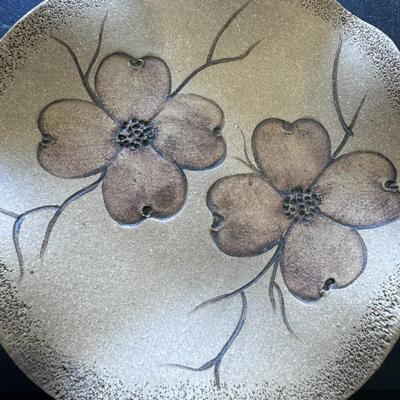
Here are some details about the item: Design: The dish showcases a distinct floral pattern, which appears to be Dogwood blossoms, carved or painted onto the surface. Material and Craftsmanship: It is crafted from clay with a tan, sand-like finish, indicative of hand-thrown or hand-built pottery. Purpose: These dishes are commonly used for holding small items like rings, earrings, or as decorative pieces for tabletops or shelves. Origin/Artist: Some similar items found online are signed by the artisan, with examples pointing to makers like "Pug, Atlanta, GA". 94 / 1369 -
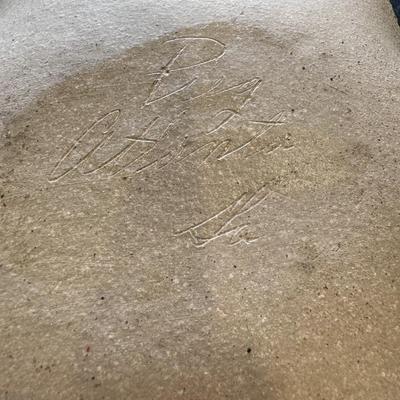
Here are some details about the item: Design: The dish showcases a distinct floral pattern, which appears to be Dogwood blossoms, carved or painted onto the surface. Material and Craftsmanship: It is crafted from clay with a tan, sand-like finish, indicative of hand-thrown or hand-built pottery. Purpose: These dishes are commonly used for holding small items like rings, earrings, or as decorative pieces for tabletops or shelves. Origin/Artist: Some similar items found online are signed by the artisan, with examples pointing to makers like "Pug, Atlanta, GA". 95 / 1369 -
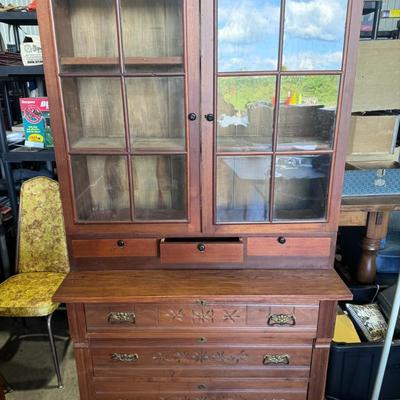
Step back in time with this Vintage Primitive 19th Century Cabinet, a true relic of early craftsmanship. Its rustic, weathered wood and simple, functional design capture the charm of a bygone era. Perfect for adding character to farmhouse, cottage, or eclectic interiors, this cabinet features ample storage with a time-worn patina that tells its own story. A unique piece that brings authenticity and history to your space, it's ideal for those who appreciate the beauty of primitive, handmade furniture. Dimensions: Height: 92 in (233.68 cm)Width: 53.25 in (135.26 cm)Depth: 23.25 in (59.06 cm) Style: Rustic (In the Style Of) Materials and Techniques: Glass,Wood Place of Origin: United States Period: Late 19th Century 96 / 1369 -
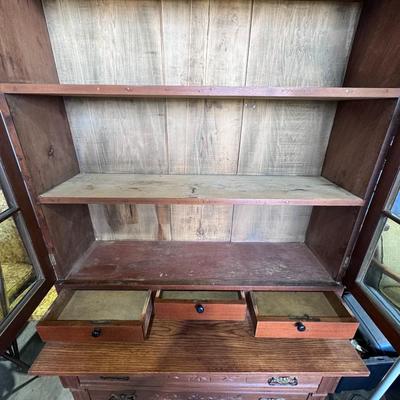
Step back in time with this Vintage Primitive 19th Century Cabinet, a true relic of early craftsmanship. Its rustic, weathered wood and simple, functional design capture the charm of a bygone era. Perfect for adding character to farmhouse, cottage, or eclectic interiors, this cabinet features ample storage with a time-worn patina that tells its own story. A unique piece that brings authenticity and history to your space, it's ideal for those who appreciate the beauty of primitive, handmade furniture. Dimensions: Height: 92 in (233.68 cm)Width: 53.25 in (135.26 cm)Depth: 23.25 in (59.06 cm) Style: Rustic (In the Style Of) Materials and Techniques: Glass,Wood Place of Origin: United States Period: Late 19th Century 97 / 1369 -
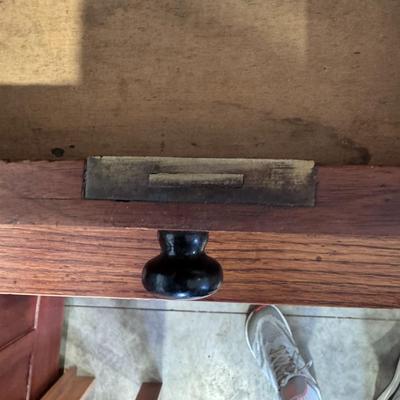
Step back in time with this Vintage Primitive 19th Century Cabinet, a true relic of early craftsmanship. Its rustic, weathered wood and simple, functional design capture the charm of a bygone era. Perfect for adding character to farmhouse, cottage, or eclectic interiors, this cabinet features ample storage with a time-worn patina that tells its own story. A unique piece that brings authenticity and history to your space, it's ideal for those who appreciate the beauty of primitive, handmade furniture. Dimensions: Height: 92 in (233.68 cm)Width: 53.25 in (135.26 cm)Depth: 23.25 in (59.06 cm) Style: Rustic (In the Style Of) Materials and Techniques: Glass,Wood Place of Origin: United States Period: Late 19th Century 98 / 1369 -
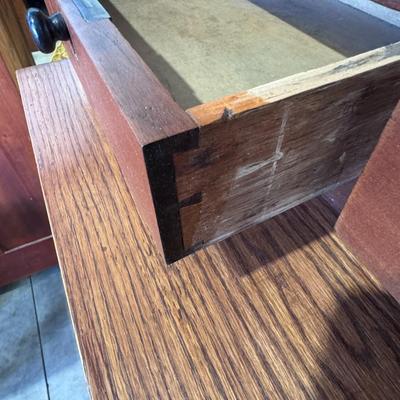
Step back in time with this Vintage Primitive 19th Century Cabinet, a true relic of early craftsmanship. Its rustic, weathered wood and simple, functional design capture the charm of a bygone era. Perfect for adding character to farmhouse, cottage, or eclectic interiors, this cabinet features ample storage with a time-worn patina that tells its own story. A unique piece that brings authenticity and history to your space, it's ideal for those who appreciate the beauty of primitive, handmade furniture. Dimensions: Height: 92 in (233.68 cm)Width: 53.25 in (135.26 cm)Depth: 23.25 in (59.06 cm) Style: Rustic (In the Style Of) Materials and Techniques: Glass,Wood Place of Origin: United States Period: Late 19th Century 99 / 1369 -
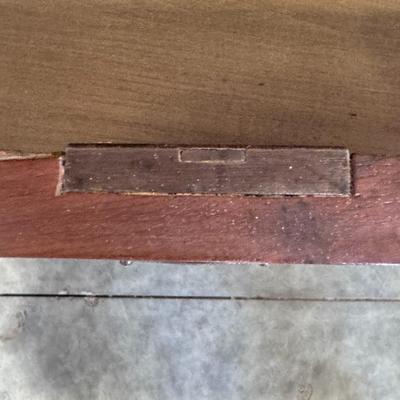
Step back in time with this Vintage Primitive 19th Century Cabinet, a true relic of early craftsmanship. Its rustic, weathered wood and simple, functional design capture the charm of a bygone era. Perfect for adding character to farmhouse, cottage, or eclectic interiors, this cabinet features ample storage with a time-worn patina that tells its own story. A unique piece that brings authenticity and history to your space, it's ideal for those who appreciate the beauty of primitive, handmade furniture. Dimensions: Height: 92 in (233.68 cm)Width: 53.25 in (135.26 cm)Depth: 23.25 in (59.06 cm) Style: Rustic (In the Style Of) Materials and Techniques: Glass,Wood Place of Origin: United States Period: Late 19th Century 100 / 1369
Photos 1 - 100 of 1369
Per page:
